
G e o r g e C .
M a r s h a l l :
S o l d i e r o f Pe a c e
M a r s h a l l P l a n :
D e f e n d i n g D e m o c r a c y
N e w L i g h t o n t h e
M a r s h a l l P l a n
M a r s h a l l P l a n Po s t e r s
T h e L a s t Wo r d
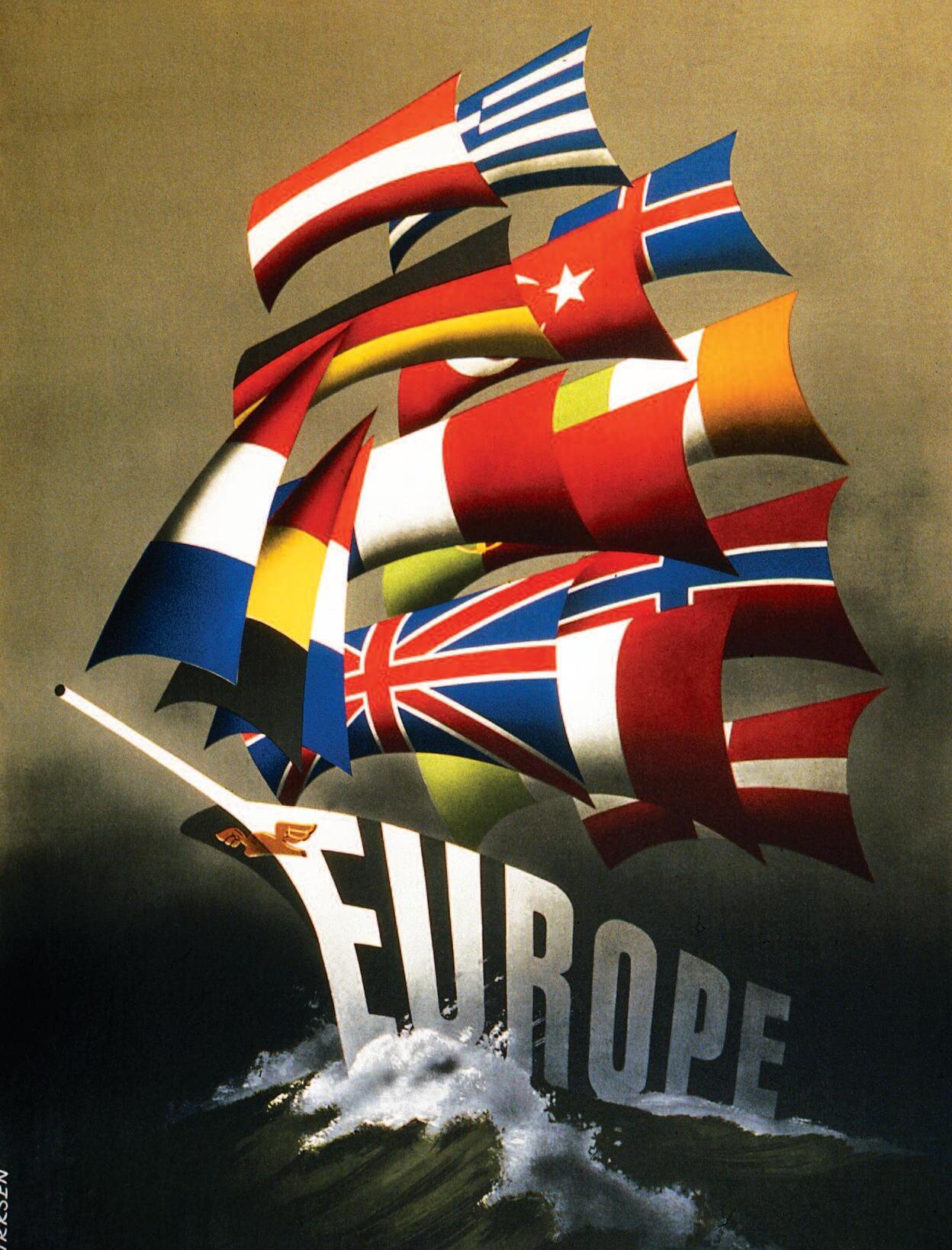

T H E M A G A Z I N E O F T H E G E O R G E C . M A R S H A L L F O U N DAT I O N
S P R I N G 2 0 1 8 V O L . 4 , N O . 1
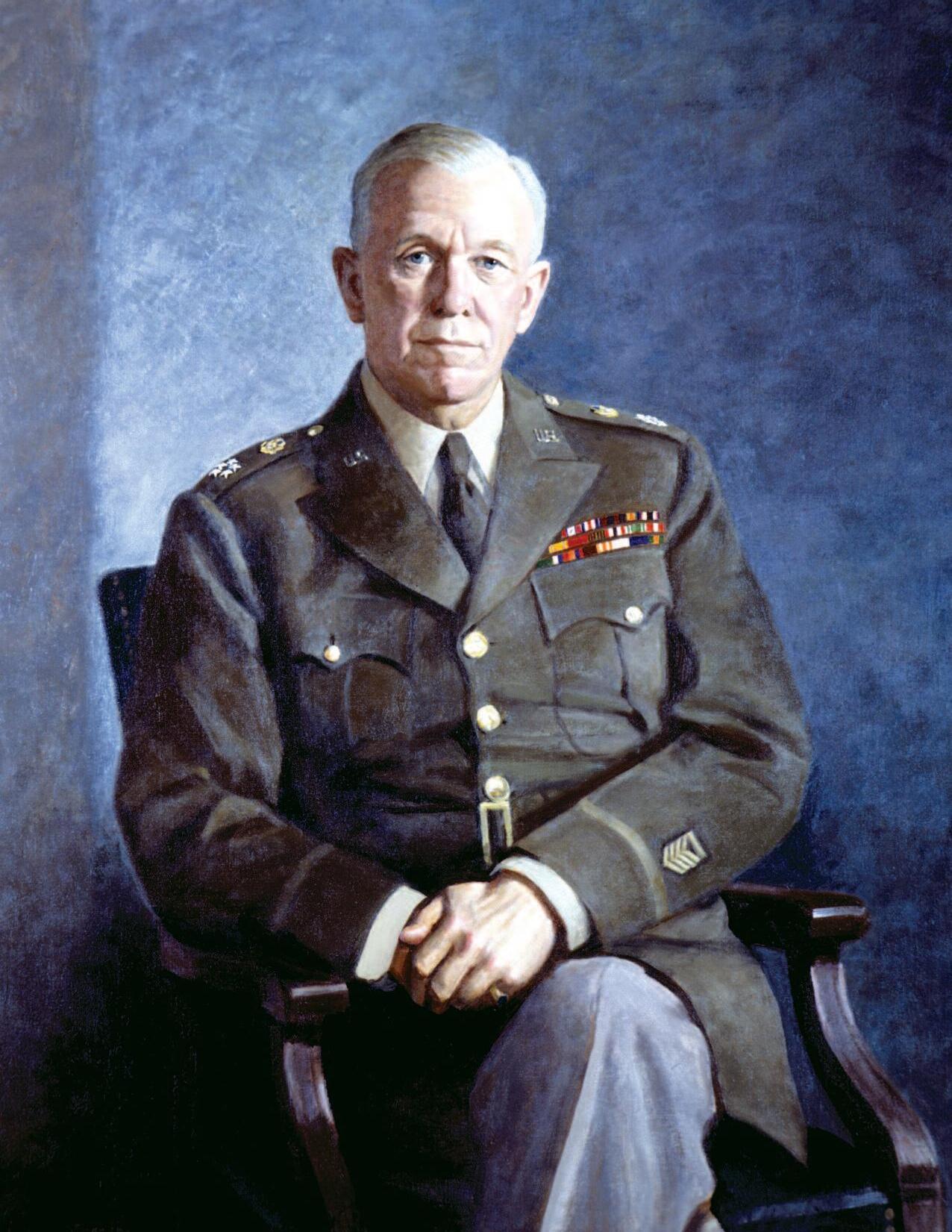
p h o t o c r e d i t G e o r g e C M a r s h a l R e s e a r c h L i b r a r y

Features

George C. Marshall: Soldier of Peace
By Mark A Stoler, Ph D
4
On October 30, 1953, General of the Army George C Marshall received word that he had been awarded the Nobel Peace Prize. In keeping with tradition, the Nobel Institute provided no explanation for giving the award or for selecting, for the first time, a professional soldier. Most commentators believed Marshall had received the prize for his work on the European Recovery Program, better known as the Marshall Plan, that he had proposed and done so much to get through Congress as secretary of state in 1947- 48. But a notable exception, the author notes, to this near-unanimous conclusion was, interestingly, Marshall himself!

The Marshall Plan: Defending Democracy
By David Hein, Ph D
14
I n his June 1947 speech at Har vard University, Secretar y of State George C Marshall affirmed that the United States should “assist in the return of normal economic health in the world, without which there can be no political stability and no assured peace.” It would be a noble deed to enable Europeans to heat their homes during brutally cold winters and to consume enough calories to gain sufficient nourishment I t would be good, too, to help them to rebuild their industrial capacity and thus their oppor tunities to par ticipate in regional and worldwide markets. But, the author maintains, these wor thy endeavors were subordinate to international security.
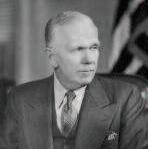
New Light on the Origins of the Marshall Plan
By Barry Machado, Ph D
22
George C Marshall, the brilliant organizer of his countr y ’s vic tor y on World War Two’s battlefields, was with equal brilliance the architec t of a revolution in America’s foreign polic y in the late 1940s. Archival digging by the author has uncovered key facets of the historical Marshall either missing or indistinct in earlier accounts of his statesmanship. A fresh understanding of the statesman Marshall what made him tick from 1947 until 1949 is that the postwar re - ordering of the Atlantic world, of which the European Recover y Program (ERP) constituted a vital par t, rested much more than previously appreciated on four personal traits that Marshall possessed as Secretar y of State: realism, a historical sensibility, a tolerance of diversity, and empathy
S P R I N G 2 0 1 8
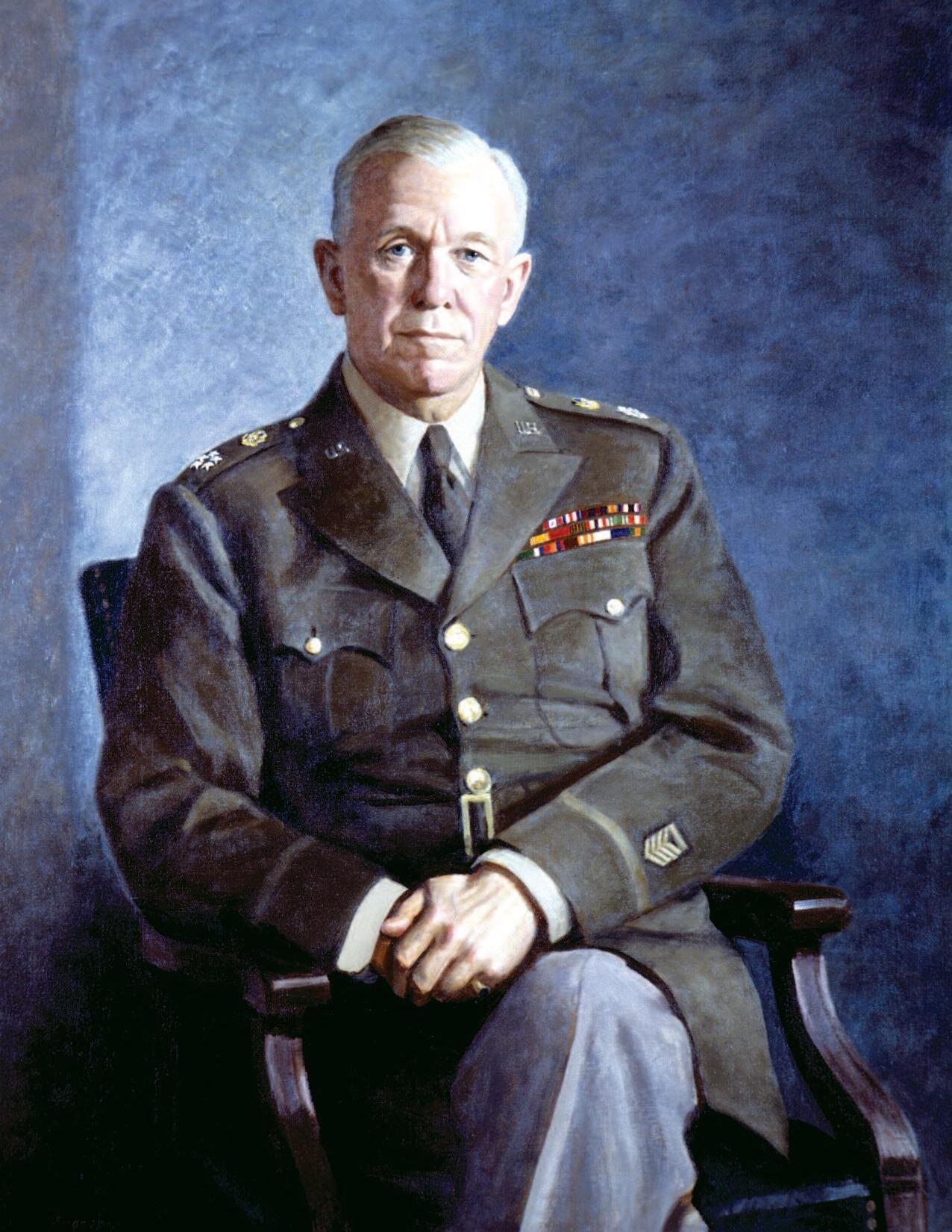
•
•
•
V O L. 4, N O. 1
M A R S H A L L is the membership magazine of the George C. Marshall Foundation. We encourage reproduc tion and use of ar ticles contained herein, with permission. Direc t correspondence and requests to the George C. Marshall Foundation, P.O. Box 1600, Lexington, VA 24450.
Telephone: 540-463-7103
Website: w w w m a r s h a l l f o u n d a t i o n o r g
Membership information is available on our webs i te. Yo u r m e m b e r s h i p s u p p o r t s p ro gra m s a n d a c t i v i t i e s d u r i n g yo u r m e m b e r s h i p ye a r B y renewing your membership, you help us perpetuate the legac y of the man President Harr y Truman called “the great one of the age.” As the keeper of the flame, the Marshall Foundation preser ves and co m m u n i c ate s t h e re m a r k a b l e s to r y o f t h e l i fe and times of George C Marshall and his contemporaries. I t has become a unique, national treasure wor th protec ting at all costs That ’s why your membership is so impor tant.
We gratefully acknowledge financial suppor t from Fe d E x f o r u n d e r w r i t i n g t h e co s t s a s s o c i a te d w i t h production of this issue
Editor: Rick Drake at e d r a k e @ m a r s h a l l f o u n d a t i o n . o r g
Contributors: Rob Havers, Rick Drake, Mark A. Stoler, Barr y Machado, David Hein, Alexis Quinn, Kevin Remington
M A R S H A L L F O U N D A T I O N O R G
D e p a r t m e n t s 3 Welcome 30 Marshall Legac y Series
Marshall Plan Posters
Best New Books about or including Marshall
Calendar for the Legac y Series
The Last Word Front cover image: “All Our Colours to the Mast,” the winning poster design in 1950 when ar tists from the 13 European nations par ticipating in the Marshall Plan submitted more than 10,000 entries in response to the theme “Intra-European Cooperation for a Better Standard of Living” (from the George C Marshall Research Librar
32
y)
welcome
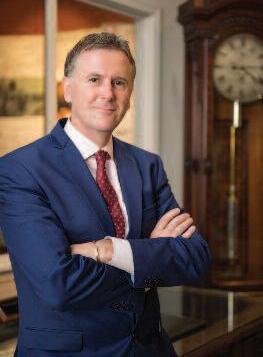
Looking back to my message in the fall issue, I commented on how “full” it was with three substantive pieces, two drawn from Marshall Legacy Series presentations. I find myself of similar opinion with this issue but with all three pieces grounded in well-attended and well-received Legacy Series events.
Firstly, Dr. Mark Stoler, editor of the final two volumes of e Papers of George Catlett Marshall and the author of (still) the best single volume biography of Marshall, writes on the enduring legacy of Marshall and how the “soldier/statesman” duality was far more of a blend than a compound in terms of who Marshall was and what he achieved. Marshall himself, as Dr. Stoler points out, considered his Nobel Prize to be for his efforts to prepare the USA to fight and to win the impending war rather than for his role in the peace that followed. In illuminating this consideration, Stoler’s article adds much to our understanding of this indispensable man.
Similarly, and appropriately, given our ongoing efforts to mark this 70th anniversar y of the passage of the European Recover y Program, our other two pieces by Dr David Hein and Dr Barr y Machado respectively, examine the Marshall Plan in action as a tool of national security, in the case of Dr. Hein’s article. Indeed this piece goes a long way to providing a fuller exposition of all the considerations that underpinned the Marshall Plan in the minds of its architects is is followed by some fresh thinking by Barr y Machado in terms of understanding the origins of the plan in Marshall’s long career Dr. Machado’s insights, to be published in a forthcoming book, are original and offer a new appraisal of George C Marshall, the man, long dominated by the particular descriptions of the four-volume Pogue biography As always, I hope you enjoy this new scholarship on Marshall and his times
I am sure you all noticed the magnificent cover art that is quite familiar to most of you “All Our Colours to the Mast” was the winner of the Marshall Plan poster competition in 1950 and wonderfully embodies the spirit and the practice of the Marshall Plan. You can read in more detail about a new exhibition that showcases all 25 of the finalists out of some 10,000 entries Although the Marshall Foundation has had copies of these images for many years, it was only in June of 2017 that we received an original set of lithographs featuring all 25 finalists for what was formally titled the “Better Standard of Living” poster contest is collection was donated by Lt Col John Lawyer, USAF (Ret ), whose father had served on the staff of the Economic Cooperation Administration in Paris at the time of the competition and received a set of the posters. e posters were in storage for many years until Colonel Lawyer rediscovered them and donated them to the Marshall Foundation where they could be viewed by visitors
Sincerely,
 Rob Havers, President
Rob Havers, President
S P R I N G 2 0 1 8 3
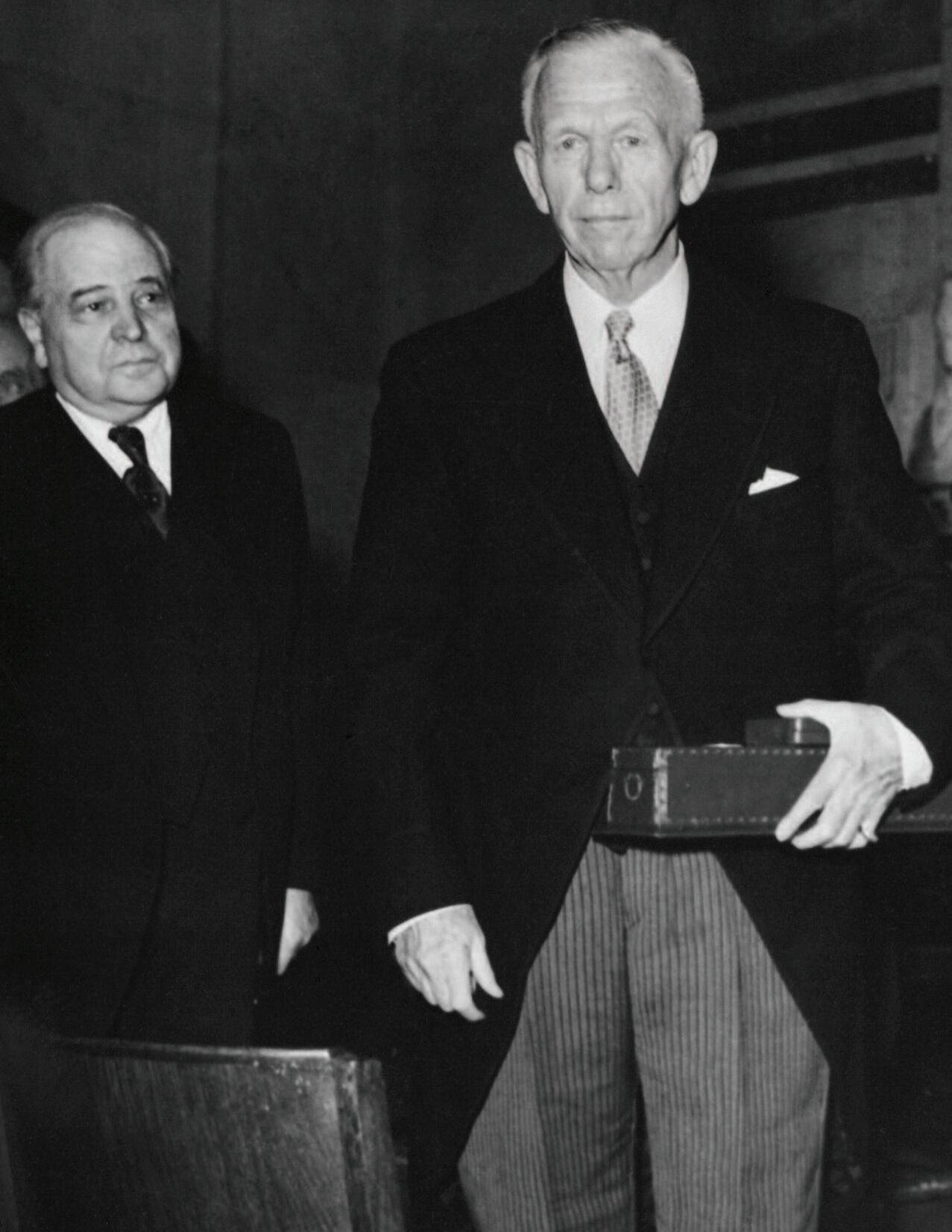
“
…I am deeply moved to find some means or method of avoiding another calamity of war. ”
4 M A R S H A L L F O U N D A T I O N O R G
p h o t o c r e d i t G e o r g e C . M a r s h a l R e s e a r c h L i b r a r y
George C. Marshall: Soldier of Peace
BY MA R K A. S TO L E R, P H.D.
On October 30, 1953, General of the Army George C. Marshall received word that he had been awarded the Nobel Peace Prize. In keeping with tradition, the Nobel Institute provided no explanation for giving the award—or for selecting, for the first time, a professional soldier.
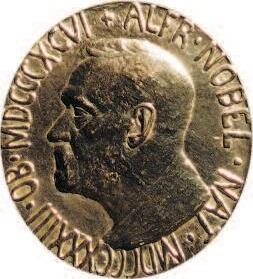

Most commentators believed Marshall had received the prize for his work n the European Recover y Program, better known as the Marshall Plan, that e had proposed and done so much to get through C ongress as secretar y of ate in 1947-48. But a notable exception to this near-unanimous conclusion as, interestingly, Marshall himself ! In his press conference on the following ay he said, according to e New York Times (and as summarized in volume of the Marshall Papers, p. 794), that “his greatest contributions to world e ace were in sp e e ding Unite d St ates prep arat ions to fig ht ag g ression in 940” when he was army chief of staff ” and “again in 1950” as secretar y of efense. Truly, he was defining himself as a “soldier of peace. ”
quating peace with militar y preparedness. at was no accident. ree times he had witness ed the United States plunge into war militarily unprepared 1917, 1941 and 1950 and each time he had been asked to help create and train a new army. As a result, he had come to believe that proper militar y preparedness cou ld have eit her aver te d war ent irely or s er iously diminished both its duration and the number of Americans who died. roughout the post-World War II years he would consequently and forcefully call, albeit unsuccessfully, for the creation of a Universal Militar y Training system (UMT) to keep the nation prepared in the future.
The Nobel Peace Prize awarded to George C. Marshall in 1953 (from the Marshall Museum display)
…he had come to believe that proper military preparedness could have either averted war entirely or seriously diminished both its duration and the number of Americans who died
Marsha l l’s first exp er ience wit h Amer ican mi lit ar y unprep are dness in war t ime o cc ur re d in 1917, when the United States entered World War I and he, as a captain and aide to the thenhospitalized General J. Franklin B ell, was in effect put in charge of mobilization in B ell’s Eastern Depar tment. He was soon shied to the staff of the First Division as head of its Operations
is article is a summar y of the author’s Marshall Legac y Series talk for e World Wars sequence delivered in October 2017. In this article Dr. Stoler has referred to other speakers in the Series. You can watch their lectures as well as Dr Stoler’s lecture on our YouTube channel

5 S P R I N G 2 0 1 8
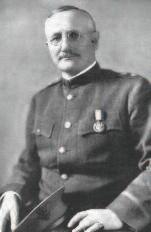
(G-3) section and sent to France, where on June 26 he followed the division commander, General William Sibert, as the first Americans to go ashore from the first convoy of U S troops
e First Division, however, was a division in name only. It had hastily been put together from understrength regiments and recent recruits and sent to France to bolster Allied morale in the face of continued militar y failures and massive casualties Many of its soldiers had only received their rifles just before boarding ship in New York and had no training in trench warfare or indeed any basic militar y behavior. In an episode he would remember for the rest of his life and oen repeat to others, an appalled and humiliated Marshall watched a disheveled U S sentr y respond to questioning from a French general about his rifle by handing the weapon over to him and then sitting down on a windowsill to roll a cigarette.
Marshall thus spent much of his time during the summer and fall of 1917 involved in training the men in his division. When General John J. Pershing, commander of the American Expeditionar y Force in France, visited First Division headquarters, he was not impressed, and during an October 3 visit he publicly blamed and thus humiliated General Sibert in front of his subordinates for the problems he saw. At that time the acting divisional chief of staff with the temporar y rank of major, Marshall sprang to Sibert’s defense. When Pershing tried to ignore him and depart, Marshall put his hand on Pershing’s arm to prevent him from leaving and angrily cited fact aer fact to show that the fault lay not with Sibert, but instead with Pershing’s own headquarters.
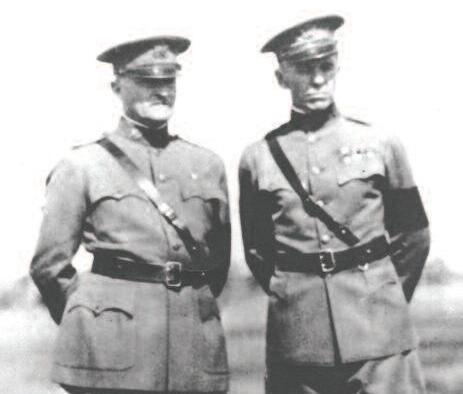
A month later Marshall challenged a French general who, in the aermath of the first U S combat deaths, had questioned t he fig ht ing qua lit ies of Amer ican t ro ops. is was one of many conflic ts t hat Amer ic an officers f rom Pershing on down wou ld have wit h t heir French and Br it ish a l lies Indeed, these officers believed that the three-year stalemate and bloodbath in the trenches had resulted from a traditional European lack of innovation and creativity that could virtually contaminate them if they allowed their forces to be “amalgamated” into French and British lines. Instead they would tr y to remain a separate force trained, in Ed Lengel’s words, in an “American Way of War” that emphasized flexibility, creativity, and open rather than trench warfare.
Despite the problems with the Allies, Marshall also learned about their importance World War I was the first U.S. experience with allies since the 1778 French Alliance during the War for Independence, an experience that had le a bad taste in many American mouths before it ended in 1800 Marshall worked with French officers on an almost daily basis and clearly learned the vital importance of having allies in any future war as well as the problems involved in working with them. As Winston Churchill would later say, the only thing worse than fighting with allies was fighting without them!
e previous confrontation with Pershing had enormous consequences for Marshall. R ather than relieving him for insubordination, Pershing came to rely upon Marshall when he visited
6 M A R S H A L L F O U N D A T I O N O R G
p h o t o c r e d i : G e o r g e C M a r s h a l R e s e a r c h L b r a y
Major General William Siber t
p h o t o c r e d t G e o g e C M a r s h a l R e s e a r c h L b r a r y
General John J Pershing (left) and Major George C Marshall formed a lasting friendship in World War I
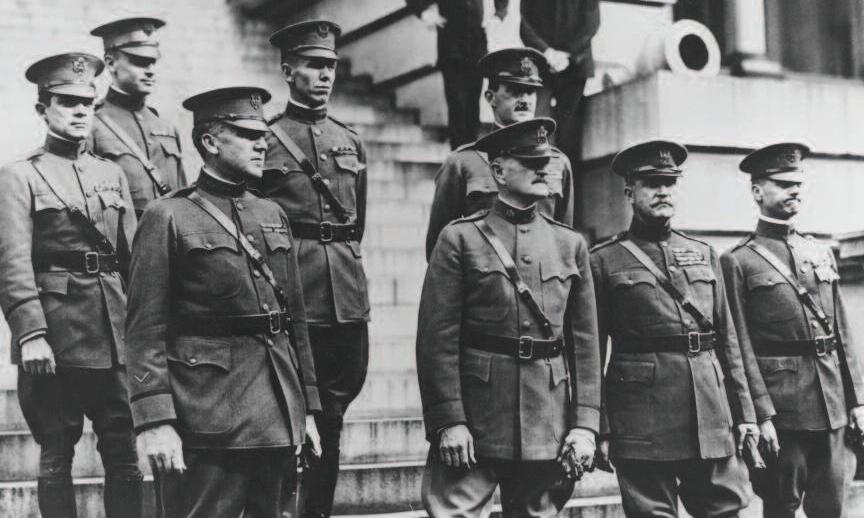
First Division headquarters, and in the summer of 1918 he had Marshall transferred to the Operations Division of his General Headquarters staff, where he ser ved under then C olonel Fox C onner and so on develop ed quite a reputation as well as the nickname “Wizard” for his planning of the U.S. offensives at St. Mihiel and the Meuse-Argonne. Since these offensives had to be carefully coordinated with those of the Allies, Marshall once again worked closely with them and learned how vital they were to victor y He also learned, once again, the inevitable problems that aros e when one had allies and the need to address thos e problems Indeed, Marshall’s World War II insistence on the creation of the Anglo-American C ombined Chiefs of Staff and the principle of “unity of command” can be traced to his World War I experiences and the lack of such unity in that conflict
ere were numerous reasons for this lack of Allied unity in World War I In a 1940 War College lecture (quoted in William T Johnsen’s e Origins of the Grand Alliance, pp 30–31), Marshall’s war time sup erior and f riend Fox C onner warned that “dealing with the enemy is a simple and straight-for ward matter when contrasted with securing close cooperation with an ally” and then explained why achieving Unity of C ommand with allies was so difficult as well as so important. Interestingly, C onner would in the 1920s also tell his young protégé D wight Eisenhower to get an assignment with Marshall if at all possible, for in the future (according to Eisenhower in At Ease, p. 192) “ we will have to fight beside allies and George Marshall knows more about the techniques of arranging Allied commands than any man I know He is nothing short of a genius ”
Members of General Pershing’s headquar ters staff included Colonel Fox Conner (front row left) and George C Marshall (third from left in the back) General Pershing stands second from left in the front row
“ we will have to fight beside allies and George Marshall knows more about the techniques of arranging Allied commands than any man I know. He is nothing short of a genius.”
Pershing clearly recognized Marshall’s genius and aer the armistice sought to retain him in any capacity he could, giving him a host of specific assignments and then, in April 1919, making Marshall one of his aides a position he continued to hold when Pershing went to Washington and became chief of staff. ere Marshall would become deeply involved in highly political as well as militar y matters concerning the future of the army and a strong supporter of the idea of Univers al Milit ar y Training (UMT) as prop os ed by his old f r iend John McAule y Palmer when Congress in 1919 debated what the postwar U S army should look like A key lesson from the wartime experience had been the lack of U.S. preparedness for war, as in effect it took a year from the declaration of war in April of 1917 for the U S Army to be ready for combat Even then it had to rely upon its allies for key war materiel
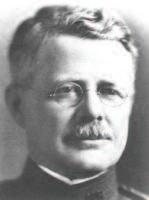
7 S P R I N G 2 0 1 8
p h o t o c r e d t G e o r g e C M a s h a R e s e a r c h L b r a r y p h o t o c e d i : G e o r g e C M a r s h a l R e s e a r c h L b r a r y
John McAuley Palmer
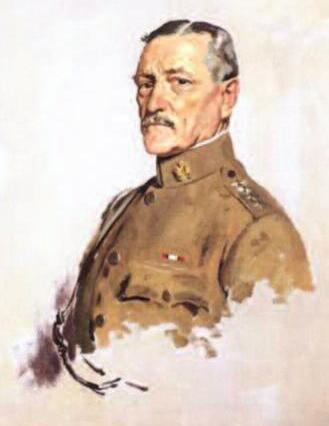
Marshall as well as Palmer saw UMT as the only democratic and affordable solution to the need for militar y preparedness in the 20th centur y given the lessons of World War I. But while C ongress agreed in 1920 to the army of just under 300,000 that Palmer and Pershing had recommended, they did so without the UMT that was to be the core of this new system Further cuts followed, and by 1939 the army was down to 175,000 and woefully unprepared for war.
is was but one of Marshall’s many experiences with C ongress while aide to Pershing exp er iences t hat cle arly prep are d him for his 1939–1945 tenure as chief of staff, during which he would establish an extraordinar y rel at ionship w it h C ong ress B e yond t hat, Marsha l l was, as Pau l B ar ron noted in his presentation, much more than just an aide to Pershing. He was also Pershing’s executive officer and virtual deputy chief of staff when the general was away as well as his protégé and perhaps even more
Pershing became Marshall’s mentor and in many ways a key father figure, as a virtual fatherson relationship developed between the two men one who had been distant from his own father and the other someone who had lost his wife and three of his children in a fire “No one knows better than I what such bereavement means, ” Pershing had telegrammed Marshall aer the 1927 death of Marshall’s first wife, Lily, “and my heart goes out to you ver y fully at this crisis in your life ” Marshall’s emotional, out-of-character and heartbreaking response (reproduced in volume 1 of the Marshall Papers, pp 315–16) revealed just how deep had become the relationship between the two men. S o did the fact that Pershing ser ved as best man when Marshall remarried in 1931
By that time Marshall was in the fourth year of his assignment as assistant commandant of the Infantr y S chool at Ft. B enning an assignment that restored his spirit and that had profound consequences for the World War II U S Army He restructured the curriculum of this school so as to emphasize what he had learned in World War I as well as from his previous experiences:
Assistant Commandant of the U S Army Infantr y School at For t Benning, Colonel Marshall sits front and center with other faculty members in 1931
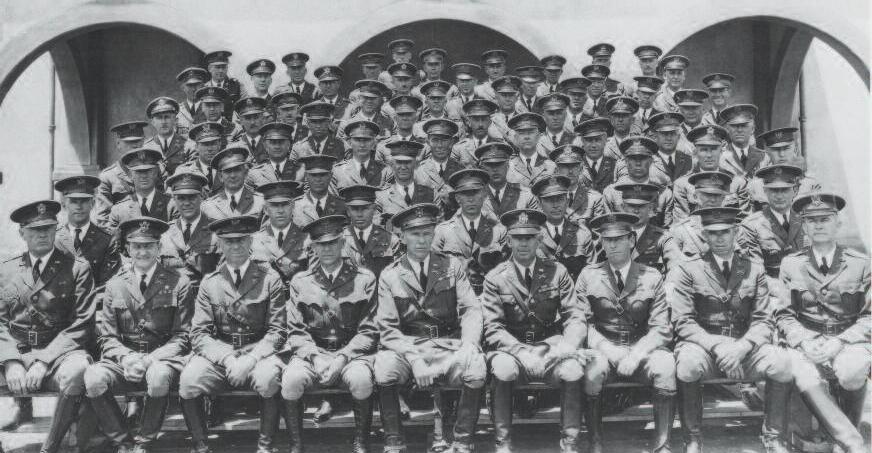
8 M A R S H A L L F O U N D A T I O N O R G
Oil por trait of General Pershing (from the collection)
p h o t o c r e d i t : G e o r g e C M a r s h a l R e s e a r c h L b r a r y p h o t o c r e d t G e o r g e C M a r s h a l R e s e a r c h L i b r a r y
t he ne e d for simplicit y in pl ans and orders and t he abi lit y to innovate and de a l w it h t he unexpected He banned written lectures, provided poor or no maps during exercises so as to duplicate confusion on the battlefield, and emphasized the need for thoughtful and original responses to the unexpected. He also emphasized training in a warfare of movement. e old American belief in this regard had been reinforced by both the World War I experience and by the revolution in warfare caused primarily by the development of the internal combustion engine which now powered tanks as well as trucks and, of course, aircra. As Dik Daso noted in his presentation, Marshall had become friends with air officer Henr y “Hap” Arnold when they and their wives lived near each other during Marshall’s second tour of duty in the Philippines from 1913–16, and that friendship would be renewed in 1938 when they were both called to Washington to ser ve in the general staff, Arnold as chief of the Army Air Corps and Marshall as first head of the War Plans Division and then deputy chief of staff.
e result of Marshall’s work at B enning was the so-called “Spirit of B enning” and the virtual creation of the American World War II militar y character, with simplicity, innovation and mobility as its hallmarks. e “B enning Revolution” also resulted in the creation of what would become the American high command in the war, as 200 future wartime generals passed through B enning’s gates during Marshall’s years there 150 as students and 50 as instructors (including Joseph Stilwell and Omar Bradley)

Aer B enning, Marshall would have a s eries of militar y p ostings that deeply involved him with civilians most notably with the Illinois National Guard and w it h t he Civ i li an C ons er vat ion C or ps (C C C), a Ne w D e a l prog ram during the Great Depression that sent unemploye d urb an yout h into t he count r yside for cons er vat ion work Since the CCC and its camps were to be organize d and r un by t he ar my, Marsha l l dur ing his p ost ings at for ts S cre ven in G e org i a and Mou lt r ie in S out h C arolina as wel l as Vancouver Barracks in Washington state faced the challenge of training and directing youth who were not in the army and who could thus not be subjected to traditional army discipline. It was a challenge he loved, and it once again gave him experiences vital to his future work en in 1938 he became deputy chief of staff and experienced an eventful first confrontation with Franklin D Roosevelt when, during a White House meeting, he openly disagreed with the president’s plans for airpower expansion. at ended the meeting and what appeared to be Marshall’s brief stay in Washington. But instead of relieving Marshall, Roosevelt would in the following year jump over 33 senior generals to appoint him the next chief of staff. As had Pershing in France, Roosevelt would accept, if not necessarily welcome, dissenting opinions from the subordinate Marshall.
9 S P R I N G 2 0 1 8
p h o t o c r e d t G e o r g e C M a r s h a l R e s e a r c h L i b r a r y
Marshall with two members of the Civilian Conser vation Corps in the 1930s in Oregon
Marshall is being sworn in as Army Chief of Staff in 1939
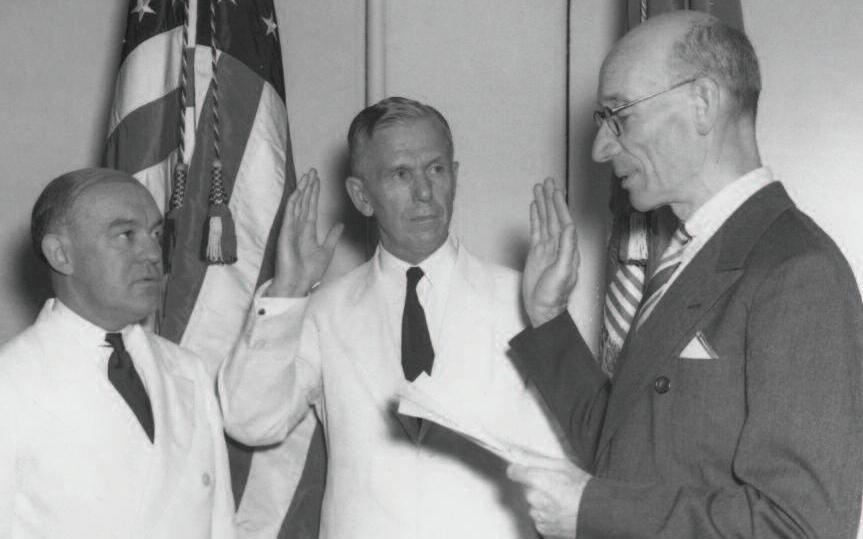
Marshall was sworn in as army chief of staff on September 1, 1939, the day Hitler invaded Poland and thereby began World War II What followed was Marshall’s second major bout with unpreparedness for war and two years that both he and many scholars agree were his most difficult as army chief. From 1939 until official U.S. entr y into the war in December of 1941, Marshall faced the daunting task of preparing for the possibility of war without alienating the large number of people in Congress as well as the rest of the countr y and even in the War Department itself opposed to U.S. inter vention. He also had to deal with a president who preferred naval and air expansion as well as material support for Britain and France over army expansion.
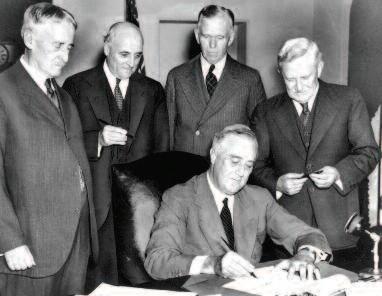
President Frank lin D Roosevelt signs legislation enabling a peacetime militar y draft in 1940 Army Chief of Staff Marshall stands behind
T h e u n e x p e c t e d a n d r ap i d G e r m a n c o n q u e s t o f F r a n c e i n t h e spr i ng of 1 9 4 0 c ame as a g re at sho ck to t he Ame r i c an p e opl e and e nsu r i ng g re at supp or t for m i l it ar y pre p are d n e ss i n clu d i ng t h e f i r s t p e a c e t i m e d r af t i n U S h i s t or y an d a m a s s i ve e x p ans i on of t h e a r my w h i c h w e nt u p f r o m 1 7 5 , 0 0 0 t o 1 . 4 m i l l i o n by D ec e mb e r of 1 9 4 1 . B ut Mar s h a l l s t i l l n e e d e d t o avoi d t a k i ng s i d e s i n t h e c o nt i nu i n g i nt e r v e nt i o n i s t / a nt i - i nt e r v e nt i o n i s t d e b at e , s om e t h i ng h e w a s ab l e t o d o by t a l k i ng of m i l it ar y pre p are d n e s s on l y f or d e f e n s e i f at t a c k e d a n d a s a w ay t o d e t e r a p o t e nt i a l e n e my f rom att a c k i ng
roug hout t his t ime p er io d Marsha l l wou ld est ablish an ext raordinar y rel at ionship w it h Congress, whose members developed an unparalleled trust in him. His relations with Roosevelt as this time were not as good or close, however, as the president continued to favor an air and naval buildup along with material aid to first Britain and then the S oviet Union via the 1941 Lend-Lease Act over army expansion and with it possible deployment in Europe.
10 M A R S H A L L F O U N D A T I O N O R G
p h o t o c e d i : G e o r g e C M a s h a l R e s e a c h L b r a y p h o t o c r e d t G e o r g e C M a r s h a l l R e s e a r c h L i b r a r y

Marshall remained determined not to repeat the World War I experience regarding Allied lack of co ordination as well as American preparedness a fac t that explains his agreement e ven before Pearl Harbor to a strateg y of alliance with Britain and defeat of Germany before Japan if the United States did go to war It also explains his call soon aer Pearl Harbor for the creation of Allied coordination machiner y designed not to repeat errors and problems he had experienced in 1917-1918. Most notable in this regard was acceptance of the principle of unity of command whereby in each theater all ground, naval and air forces of both powers would be placed under a sing le commander and the creation of the C ombined Chiefs of Staff (C CS) C omposed of the American and British army, navy and air chiefs, this body would determine how their combined forces would b e us ed and would rep or t directly to Roosevelt and Churchill, each of whom had a pers ona l mi lit ar y repres ent at ive on t he C CS as wel l. en in March of 1942, Marshall totally reorganized the general staff and in the process created three autonomous super commands rep or t ing dire c t ly to him s er v ice of supply, ar my g round forces, and army air forces as well as a new Operations Division to replace the Old War Plans Division and ser ve as his “Washington C ommand Post ” To run Army Air Forces Marshall appointed and supported his old friend Hap Arnold, even placing him on the new Joint Chiefs of Staff as well as the CCS even though he was technically Marshall’s subordinate.
Throughout this time period Marshall would establish an extraordinary relationship with Congress, whose members developed an unparalleled trust in him
ese moves did not eliminate Allied or inter-ser vice disagreements at was not possible, as C onner had noted in his 1940 War C ollege lecture But they provided organizational structures in which these disagreements could be thrashed out and resolved.
e largest Anglo-American disagreement, as Brad C oleman and Nigel Hamilton explained in their presentations, was over how to defeat Germany first with Marshall’s “direct” approach across the English Channel pitted against Britain’s “peripheral” approach in North Africa and the Mediterranean is dispute was not finally settled until the first “Big ree” meeting in Tehran in November of 1943, when Roosevelt and Soviet leader Josef Stalin outvoted Churchill and forced him to agree to Operation OVERLORD for 1944.
11 S P R I N G 2 0 1 8
p h o t o c r e d t G e o r g e C M a r s h a l R e s e a r c h L i b r a r y
Members of the World War II Combined Chiefs of Staff in Potsdam in 1945 Marshall sits on the right, flanked by U S Army General Henr y H “Hap” Arnold to his left and U S Navy Chief Admiral Ernest King to his right

ere were also serious disagreements within both the CCS and the JCS over Europe vs Pacific, for despite formal agreement to the Germany-first strateg y, more U.S. forces would be deployed in Asia and the Pacific than in Europe until late 1943 Also notable were disputes over which route in the Pacific should be favored and over relations with MacArthur which as Jim Z obel pointed out in his presentation, were far from being as bitter during the war as they are usually portrayed C ontrar y to popular belief, MacArthur as chief of staff did not tr y to cripple Marshall’s career by sending him to Chicago to train the Illinois National Guard in 1935. In fact he had recommended Marshall for promotion to brigadier general and saw the Chicago assignment as vital in light of the B onus March a few years earlier and his fear of labor violence and/or insurrection in the face of the Great Depression. MacArthur did feel betrayed by FDR and Marshall over what he considered his “abandonment” in the Philippines in 1941– early 1942, and he opposed the Europe-first strateg y throughout the war, suffering what Marshall would refer to as “localitis.” MacArthur also never realized that Marshall was, in Z obel’s words, “his greatest ally” in Washington, recommending him for the Medal of Honor and convincing FDR to withdraw him from the Philippines to head the S outhwest Pacific theater (SWPA) from Australia

at wou ld le ad to maj or conflic ts w it h Nav y C hief Admira l Ernest J King, who wanted to shut SWPA down and focus all attention on Admiral Chester Nimitz’s Central Pacific drive He had let the army take the lead in Europe, King reasoned, so Marshall should let the Navy take the lead in the Pacific is conflict only compounded other problems Marshall had with the ver y prickly and diffic ult King an admiral r umored to shave wit h a blowtorch. “He is the most even-tempered man in the world,” one of his daughters quipped; “he is always in a rage ” But interser vice cooperation was a top priority for Marshall, and he even went to King’s office once to apologize for keeping the admiral waiting.
Marshall also remained deeply involved in the continued expansion of the army, which would grow (with inclusion of the AAF) to 10.4 million by 1945. In appointing generals to high command in this massive force, Marshall relied, as Stephen Taaffe noted, upon the officer’s character, militar y education, youth, and his knowledge of them either personally or through close and trusted associates from World War I or B enning who knew the officers involved, with Conner protégé Eisenhower as a classic example of the latter. As Taaffe also pointed out, army forces would be organized into 89 divisions, 20 corps and 8-9 field armies for overseas deployment a small number of divisions compared to the Germans and the Soviets. is “90 division gamble” worked, but barely, as army ground forces faced a manpower crisis during the late 1944 “Battle of the Bulge ” e gamble was also based on continued reliance on Soviet forces, who throughout the war both inflicted casualties on the Germans and suffered themselves casualties that dwarfed those suffered by Anglo-American forces, to confront the bulk of the German Army.
12 M A R S H A L L F O U N D A T I O N O R G
General MacAr thur in August 1945
p h o t o c r e d i t : G e o r g e C M a r s h a l R e s e a r c h L b r a y p h o t o c r e d i t G e o r g e C M a r s h a R e s e a r c h L b r a r y
Chief of Naval Operations Admiral Ernest King and Army Chief General Marshall
Although a strong supporter of air power, Marshall had to consistently fight the myth that it alone could win the war In the end, he would say, it always came down to “the guy in the mud ”
Indeed, as Conrad Crane noted in his presentation on airpower myths, the entire strategic bombing campaign was a costly failure until the end of 1943, when ne w long-range fighter aircra could accompany the bombers over Germany and the primar y objective shied from destruction of German morale and industr y to destruction of the Luwaffe.
Marshall was also deeply involved during the war in postwar planning for the army. Indeed in his 1945 published biannual report, he made a major push for UMT as the best and only suitable postwar defense policy for the United States.

Considering all these as well as his numerous other responsibilities, Marshall was in effect r unning and co ordinating the entire U.S. global war effort. So great was the national respect for him that Time magazine would name him its 1943 “Man of the Year.” Yet for that ver y reas on he would b e denied the OVERLORD command, with Ro os e velt telling him that he “could not sleep at night with you out of the countr y. ” On V-E Day tributes poured in to him as, in Churchill’s words, “the true organizer of victor y, ” with the elderly Secretar y of War Henr y L. Stimson in the most moving tribute calling him “the finest soldier I have ever known ”
In his Nobel Prize speech (reproduced in volume 7 of the Marshall Papers, pp. 810-16), Marshall explained why a soldier receiving a peace prize did not seem “ as remarkable to me as it apparently does to others I know a great deal of the horrors and tragedies of war, ” he explained “ e cost of war in human lives is constantly spread before me, written neatly in many ledgers whose columns are gravestones. I am deeply moved to find some means or method of avoiding another calamity of war ” As this presentation has hopefully pointed out, Marshall saw militar y unpreparedness as a major caus e of war and preparedness as a way to pre vent war. His preferred method, indeed the only appropriate method for American society, he claimed, was Universal Militar y Training something he was never able to obtain Despite that fact, what he had accomplished was extraordinar y. “I hope I have sown some seeds which may bring forth good fruit,” he said with typical modesty in concluding his Nobel Prize Lecture. He certainly had.
Mark A. Stoler is professor emeritus of histor y at the University of Vermont and editor of The Papers of George Catlett Marshall, Volumes 6 and 7.
Dr Stoler is the author of Allies and Adversaries: The J oint Chiefs of Sta ff, the Grand Alliance, and U.S. Strategy in World War II (2000), which won the 2002 O utstanding B ook Award of the Society of Militar y Histor y, as well as G eorge C. M a r s h a l l : S o l d i e r- S t a t e s m a n o f t h e A m e r i ca n Centur y among other notable publications.

13 S P R I N G 2 0 1 8
p h o t o c r e d t G e o r g e C M a r s h a R e s e a r c h L b r a r y
George C Marshall at the Nobel Peace Prize ceremony in Oslo in 1953
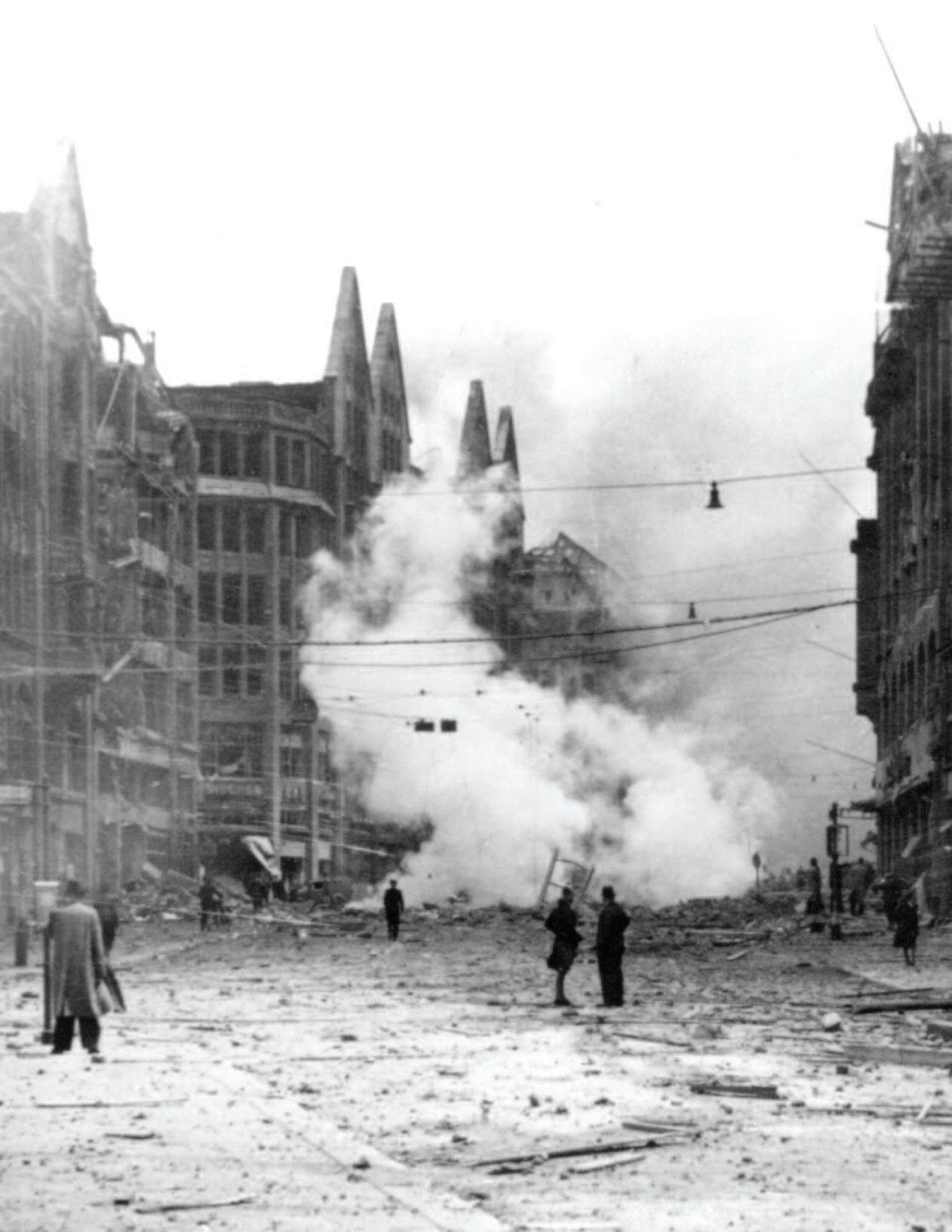
Secretary Marshall was confident that beneath the rubble of war-torn cities lay a strong foundation on which to build our mutual security commitments
M A R S H A L L F O U N D A T I O N O R G p h o t o c r e d i t : G e o r g e C M a r s h a l l R e s e a r c h L i b r a r y
The Marshall Plan: Defending Democracy
BY DAV I D H E I N, P H D
I n h i s J u n e 5 , 1 9 4 7 s p e e c h a t H a r va r d U n i ve r s i t y, S e c r e t a r y o f State George C. Marshall affirmed that the United States should “ a s s i s t i n t h e r e t u r n o f n o r m a l e c o n o m i c h e a l t h i n t h e wo r l d , without which there can be no political stability and no assured p e a c e. O u r p o l i c y i s d i r e c t e d , ” h e a s s u r e d h i s l i s t e n e r s, “ n o t a g a i n s t a ny c o u n t r y o r d o c t r i n e b u t a g a i n s t h u n g e r, p ove r t y, desperation and chaos.” This program ’ s “ purpose should be the r e v i va l o f a wo r k i n g e c o n o my i n t h e wo r l d s o a s t o p e r m i t t h e e m e r g e n c e o f p o l i t i c a l a n d s o c i a l c o n d i t i o n s i n w h i c h f r e e
i n s t i t u t i o n s c a n e x i s t . ”
It would be a noble deed to enable Europeans to heat their homes during brutally cold winters and to consume enough calories to gain sufficient nourishment It would be good, too, to help them to rebuild their industrial capacity and thus their opportunities to participate in regional and worldwide markets. But these worthy endeavors were subordinate to international security
us Ar min Gr ünb acher, in an ar t icle in C e ntral European Histor y (2012), provides a reading of this program that takes into account the harsh realities of the E ast-West conflict He points out that “the originally propagated view that the Marshall Plan was an altruistic endeavor through which the U.S. saved Europe f rom col l aps e and st ar vat ion has long b e en dismiss e d and replaced with a more realistic approach to international affairs ”
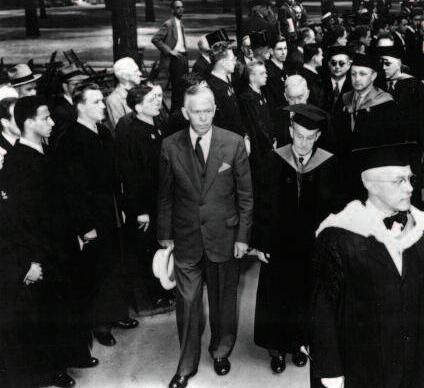
In t he ye ars imme di ately fol low ing t he S e cond World War, he s ays, “Realpolitik and t he perception of the evermore menacing C old War made it inevitable that Marshall Plan aid would become a weapon in the conflict ”
is article is a summar y of the author’s Marshall Legacy Series talk for the Europe’s Unlikely Recovery sequence delivered in March 2018. You can watch Dr. Hein’s lecture as well as other lectures in the Legac y Series on our YouTube channel

15 S P R I N G 2 0 1 8
Marshall’s speech at Har vard announced the intention of European recover y
p h o t o c r e d t G e o r g e C M a s h a l R e s e a r c h L b a r y

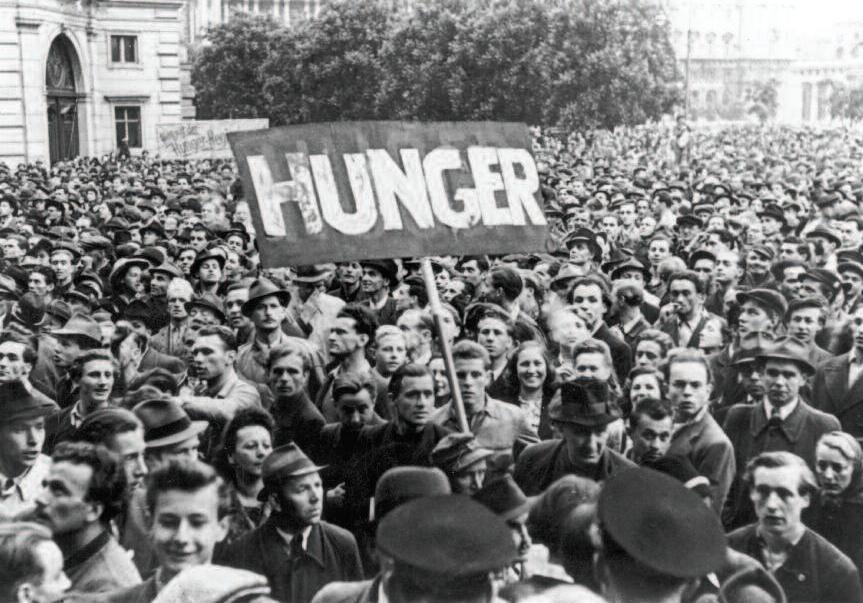
For George Kennan, the head of Marshall’s polic y planning staff, there were only five centers of industrial and war-making capacity in the world that were important to the national security of the United States: the U S , Britain, G ermany and C entral Europ e, the S oviet Union, and Japan. One of these five, the S oviet Union, was already in hostile hands; the U.S. must make sure t hat no ot hers fel l to t he S ov iets. Kennan s aw t he Marsha l l Pl an as an inst r ument of Communist containment e success of containment depended on boosting confidence in the democratic leadership of Western Europe. It was essential to strengthen not only France and Britain but also the three western zones of occupied Germany and to tie them to the West. e p ossibi lity t hat a l l of G er many wou ld inste ad b e come lin ke d to t he S oviet Union histor ian Melvyn Leffler refers to as the “strategic nightmare” of George Marshall and U S policy makers
Kennan saw the Marshall Plan as an instrument of Communist containment.
The success of containment depended on boosting confidence in the democratic leadership of Western Europe.

A key concept behind the Marshall Plan was that money, not arms, must be the primar y tool for promoting geopolitical stability e USSR had the lead in ground forces: the huge Red Army. U.S. planners did not expect that Moscow, still suffering from the last war and lacking strong naval and air forces, would start a war But in late 1947, CIA analysts determined that even if the S oviet Union did not opt for open militar y aggression, it would still attempt to “build up its war potential and…extend its influence and control by political, economic, and psychological methods ” And on that playing field political, economic, psychological the ERP (European Recover y Program) could prudently compete, applying U.S. strength to the adversar y ’ s weakness in the most effective manner.
Now in addition to idealistic humanitarianism and realistic defense strateg y, there’s a third fiber in the cord which is the Marshall Plan. Recall the Potsdam Conference, held in July 1945, where the conferees created the Council of Foreign Ministers. is body was to negotiate peace treaties with former enemy nations Meetings were held in London, Paris, and New York, producing treaties with Bulgaria, Finland, Hungar y, Italy, and Romania.
en the crucial fourth set of meetings began on March 10, 1947, in Moscow. Now if you had been Secretar y George C Marshall in the Soviet capital back then, you would have been painfully
16 M A R S H A L L F O U N D A T I O N O R G
p h o t o c r e d t G e o r g e C M a s h a l R e s e a r c h L b a r y p h o o c r e d t G e o r g e C M a r s h a R e s e a r c h L i b r a r y
Residents of Vienna in protest
George Kennan
aware of the fact that this meeting was b ecoming increasingly hard to sit through, both physically and psychologically. Playing for time, seeking to allow conditions in Western Europe to deteriorate further, Stalin was hoping to see these countries bleed to the point of exhaustion f rom the wounds the y’d suffered in wartime At the Moscow Conference, we see the ending of World War II overlapping with the beginning of the Cold War.
Focused on the future of Germany, this conference covere d not merely c ash and co a l and steel and heavy equipment. Values were a ls o at t he he ar t of t he matter e Unite d States noted that the Allied C ontrol Authority had been directed to prepare for the eventual reconstruction of German political life on a democratic basis
But what was democrac y? General Marshall and his team worked to make that directive more pre cis e: e s e cret ar y of st ate made clear to his fellow conferees that democrac y means not just a way of voting and governing but also, more fundamentally, inalienable rights, which may not be taken away ese rights include “the right of ever y individual to develop his mind and his soul in ways of his own choice, free of fear or coercion provided he does not interfere with the like right of others.” And Marshall noted that “ To us a society is not democratic if men are not free to express their own beliefs and convictions without fear that they may be snatched away from their home and family.”
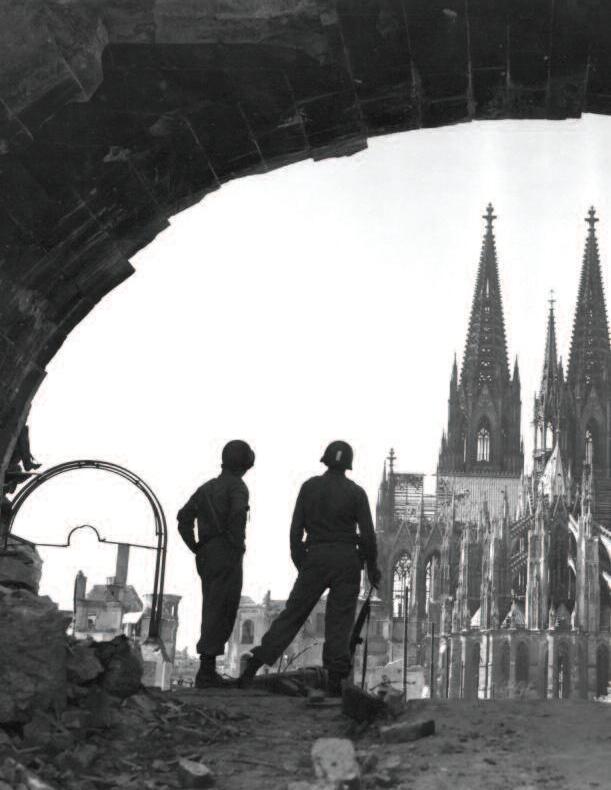
Within the goals of the Marshall Plan, including humanitarian relief and international-security strateg y, where does reestablishing Europeans’ confidence in free governments fit in? S omewhere in between idealism and realism. And in between means and ends. Maintaining free, autonomous governments would reaffirm Western Europeans’ bonds with the United States: their shared traditions and common values
But freedom and democrac y were also, from Marshall’s point of view, desirable ends, good in and of themselves. Securing democracy would help to keep the peace. Keeping the peace would help democratic governments to grow And boosting confidence both in the economy and in democrac y would help to prevent a desperate lurching into the C ommunist brand of stability and social harmony. e Marshall Plan affirmed that free markets and basic human rights and food security were mutually reinforcing: good in and of themselves and contributor y to a just and lasting peace.
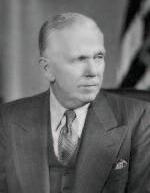
17 S P R I N G 2 0 1 8
caption p h o t o c r e d t G e o r g e C M a r s h a R e s e a r c h L i b r a r y p h o t o c r e d t G e o r g e C M a r s h a R e s e a r c h L b r a y
Secretar y of State Marshall
Soldiers standing in the rubble in Cologne
e piece of this Marshall Plan puzzle that has perhaps been a trifle overlooked is this role of democrac y e reason may be that democrac y ’ s use at the time looks too much like a slogan in the propaganda war democracy versus totalitarianism, freedom versus slaver y and therefore an obv ious p ar t of t he s a les pitch in t his p ost war p er io d of bip ol ar comp et it ion. And perhaps democrac y ’ s role has been discounted too because proclaiming it looks disingenuous in an era in which the United States supported strong-man regimes if they were on the right side in the C old War.
And yet there is no doubt that George C Marshall was truly committed to the principles and practices of democrac y, even when this open, participator y form of government caused him problems. On June 14, 1948, in a letter to a fellow alumnus of VMI, Marshall exclaimed: “God bless democrac y! I approve of it highly but suffer from it extremely ”
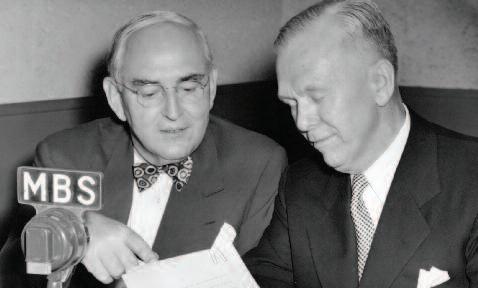
O ver t he pre v ious ye ar, t he s e cret ar y of st ate had immers e d hims elf in Amer ic an demo crac y : crossing t he United St ates, explaining, arguing for, s elling t he European Recover y Program (ERP), and also playing a huge role in working with leading figures in C ongress, such as Michigan’s Republican Senator Arthur Vandenberg, to secure its passage. Marshall’s speeches on the hustings when he was setting forth this plan’s principles and objectives can be discounted as campaign rhetoric to some extent But his words carr y the ring of truth
people
In B oston, Massachusetts, on October 15, 1947, Marshall told the C ongress of Industrial Organizations that “the basic issue is simply whether or not men are to be le free to organize their social, political and economic existence in accordance with their desires; or whether they are to have their lives arranged and dictated to them by small groups of men who have arrogated to themselves this arbitrar y power ”
“…The great enemy of democracy has always been the concentration of arbitrary power in a few hands.”
As we ’ ve seen, in Marshall’s way of thinking, democrac y did not mean simply a mode of selecting leaders, a political process. His concern was with preser ving a form of government that ensured individuals’ basic rights In his speech to the CIO, he said that the political problem “in the world to day has assumed more menacing prop or tions t han e ver b efore. e g re at enemy of demo crac y has a lways been the concentration of arbitrar y power in a few hands.” is concentration, he b elie ved, would lead to the de valuation of basic human rights. “ e particular theor y used as a justification for the suppression and eventual elimination of civil liber ties varies with the times,” he said But “all such theories contain within themselves the greatest of all human fallacies, that in human affairs the end justifies the means. ”
is phras e “the end justifies the means ” is amply illustrated in Ar thur Ko estler’s classic anti-C ommunist novel, Darkness at Noon: Life and death, truth and lies, the individual and the masses: all take on meaning and value only in relation to the center-of-value, the State, which
18 M A R S H A L L F O U N D A T I O N O R G
p h o t o c r e d t G e o g e C M a r s h a R e s e a r c h L b r a y
Senator Ar thur Vandenberg and Secretar y Marshall sold the plan to the American
means the Party, which is ruled by No 1, who is Stalin And the Party justifies its lies, its killings, its ruthless and relentless denial of the first-person pronoun “I” all in the name of an everreceding future, an end-state of perfect justice and harmony. is ideal future goal justifies all the present horrors.
“Because the economic stability of Europe is essential to the political stability of Europe, it is of tremendous importance to us, to our peace and security, and it is equally important to the entire world.”
e threads composing the Marshall Plan’s goals are indicated at the close of Marshall’s speech: “B ecause the economic stability of Europe is essential to the political stability of Europe, it is of tremendous importance to us, to our peace and security, and it is equally important to the entire world.” In other words, economic re vitalization will foster confidence in demo cratic institutions in a free society And this commitment will align w it h t he ge op olit ic a l st rateg ic interests of t he Unite d St ates, contributing “to our peace and security.” But then he immediately goes on beyond economic and security interests: “We are faced with the danger of the actual disappearance of the characteristics of western civilization on which our government and our manner of living are based.”
What Marsha l l me ant by demo crac y in Europ e was, as he put it in a sp e e ch in C hicago on November 18, “ a position of stability so it [Europe] could work out its own problem,” rather than a situation in which it would “be kept in a state of permanent dependenc y and eventual absorption into a system alien to its traditions and civilization.” And he made clear an essential element of t he Marsha l l Pl an C ent ra l to Europ e an t radit ions is “t he r u le of imp ar t i a l l aw as against the exercise of arbitrar y power ” He pointed to a postwar “political and economic vacuum ” in Europe, in which these time-honored institutions were threatened.
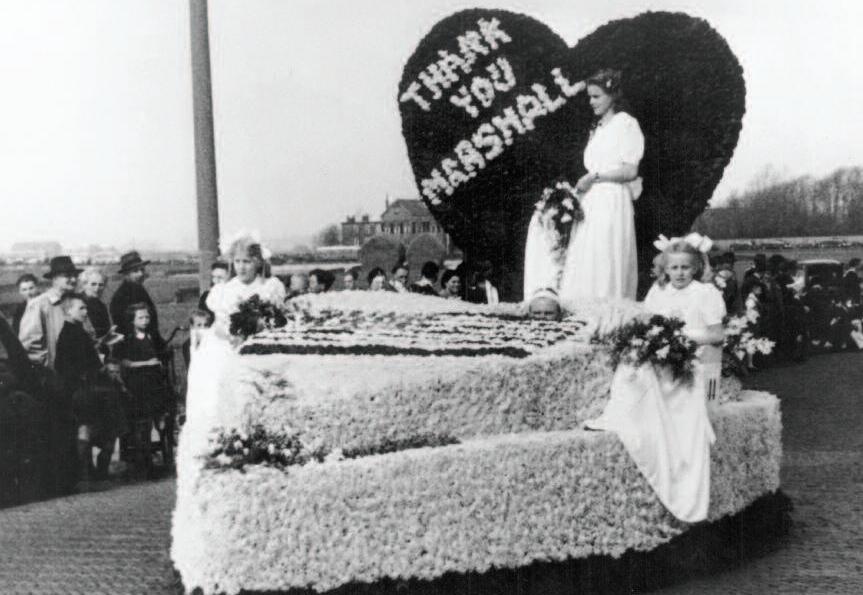
19 S P R I N G 2 0 1 8
p h o t o c r e d t G e o r g e C M a r s h a R e s e a r c h L b r a r y
Marshall Plan parade in the Netherlands
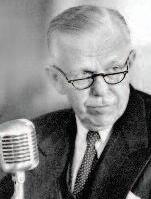
On Januar y 8, 1948, before the Senate Foreign Relations Committee, Marshall warned that support of the ERP should not be given “for light or sentimental reasons ” Support should be based instead on “the highest considerations of national interest.” And there are no higher national interests than these two: “the establishment of enduring peace ” and “the maintenance of true freedom for the individual ” He asked that in the coming weeks the ERP “be judged in these terms and on this basis.”
…there are no higher national interests than these two:
“the establishment of enduring peace ” and “the maintenance of true freedom for the individual.”
Now the fact that ideals, not just material products, count for something becomes important in t he histor ic a l ana lysis of t he Marsha l l Pl an ’ s ac tu a l not just myt hic a l imp ac t on t he st rengt h of C ommunist p ar t ies in wester n Europ e in t he l ate for t ies. e histor i an B ar r y Machado makes a strong case for the position that “belly Communism” poverty, unemployment, and miser y as incubators of Communism has been overemphasized and that Communism retained much of its appeal in France and Italy.
e Marshall Plan curb ed the growth of C ommunism, he points out, but defections by the hard core were minimal. Idealistic, utopian, cultural, historical, and other reasons also had important roles in Europeans’ continuing Communist Party commitments Machado notes that many French citizens patriotically admired Communists in World War II, for Party members oen made courageous Resistance fighters. But for other citizens, General Marshall’s and western democracies’ credible commitment to human rights undoubtedly found considerable traction
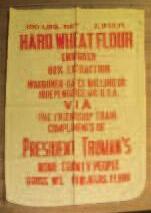
Marshall was for a system in which persons are viewed as ends and not as means. In which human beings’ basic liberties are preser ved. In which citizens have the freedom and security that make striving and generosity, duty and sacrifice, both possible and meaningful
Wit hout refer r ing to t he Europ e an R e cover y Prog ram at a l l, in a re cent ess ay t he Eng lish phi los opher R oger S cr uton t hrows considerable lig ht on our main t hemes (“ e C as e for Nations,” Wall Street Journal, June 3, 2017) Democrac y, he says, requires a demos, a people, united by “ a prepolitical loyalty,” rooted in a common territor y, histor y, and culture. e rule of l aw dep ends up on “ a legac y of s o ci a l t r ust,” such as t he Amer ic ans and t he Br it ish have enjoyed for centuries A nation’s stability may be bolstered by economic growth, but essential to “enduring peace ” are mutual tr ust and shared resolution, expressed through “institutions that foster collective decisions in response to the problems of the day.”
When, in Marshall’s words, “chaos” and “desperation” gain the upper hand, social cohesion may break down, and with it, the shared commitment, the national loyalty, that makes democrac y and the rule of law work. Economic security can provide a boost in national confidence, Scruton obser ves, but with it must also come a renewed focus on citizens’ common histor y and culture, their loyalty to shared principles and values transcending the boundaries and barriers of class, of family, of religion. Historically, that’s exactly what ERP funds helped the citizens within t he var ious nat ions of Wester n Europ e to accomplish, as workers, consumers, and ow ners sought the common good rather than accepting ongoing strife and societal breakdown
20 M A R S H A L L F O U N D A T I O N O R G
p h o t o c e d i : G e o r g e C M a r s h a l R e s e a r c h L b r a r y
p h o t o c r e d i t G e o r g e C M a r s h a l l R e s e a c h L b r a r y
Marshall takes questions
Flour sack from a miller in Independence, MO
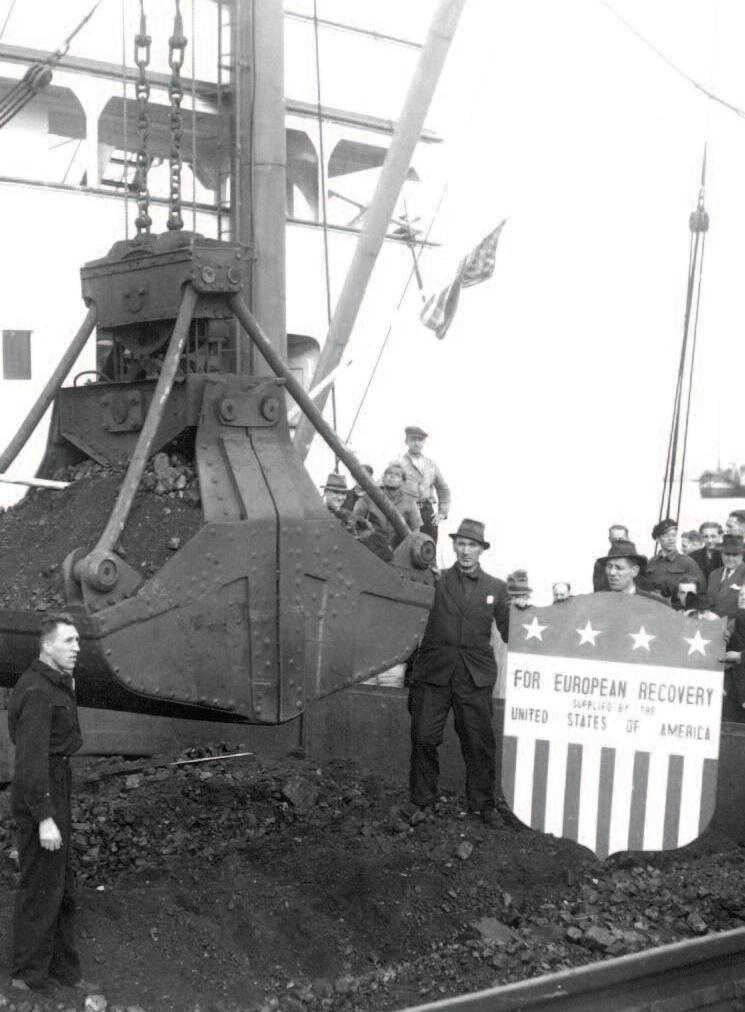
is histor y is w hat p e ople at t he t ime and historians later pointed to w hen t he y sp oke of t he rene wa l of confidence, t he restorat ion of hop e, the fortified commitment to demo crac y w hich c ame w it h t he Marsha l l Plan. Aer World War II, the United States did not ab andon t he nat ions of Wester n Europ e. e Marsha l l Pl an resp e c te d these nations’ institutions and leaders, their individu a l go a ls and p olicies. And t he ERP refle c te d our share d commit ment to demo crat ic va lues, express e d in for ms dist inc t ive to t he t radit ions and c u ltures of t he European nations
S e cret ar y Marsha l l was confident t hat b ene at h
the r ubble of war-torn cities lay a strong foundation on which to build our mutual security commitments. But this foundation would never be solid bedrock, a gray monolith that citizens could take for granted. Rather, this foundation was a variegated mixture, whose strength derived from both unique national sources of identity and core principles of law and democrac y, of individual freedom and minority rights, that bound these nations together in common purpose and shared endeavor.
David Hein, Ph D , is a senior fellow at the George C. Marshall Foundation and an affiliated scholar of the John Jay Institute. Related ar ticles by this author include “In War for Peace: General George C Marshall’s Core Convic tions and Ethical Leadership,” Touchstone (2013); “Ronald Reagan and George C. Marshall: A Cold War Affinity,” St. Croix Review (2016); “General George C. Marshall: Why He Still Matters,” Marshall: The Maga-
zine of the George C Marshall Foundation (2016); “ The M arshall Plan: Conser vative R efor m as a Weapon of War,” Modern Age (2017); “Niebuhr ’s Irony of A merican Histor y: Still Vital at 65,” The Imaginative Conser vative (2017); and “G eorge Washington and G eorge C. M arshall: The Persistence of Duty,” Modern Age (2018).
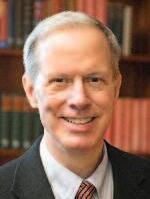
21 S P R I N G 2 0 1 8
p h o t o c e d i : G e o r g e C M a r s h a l R e s e a r c h L b r a r y
Marshall Plan aid restored hope
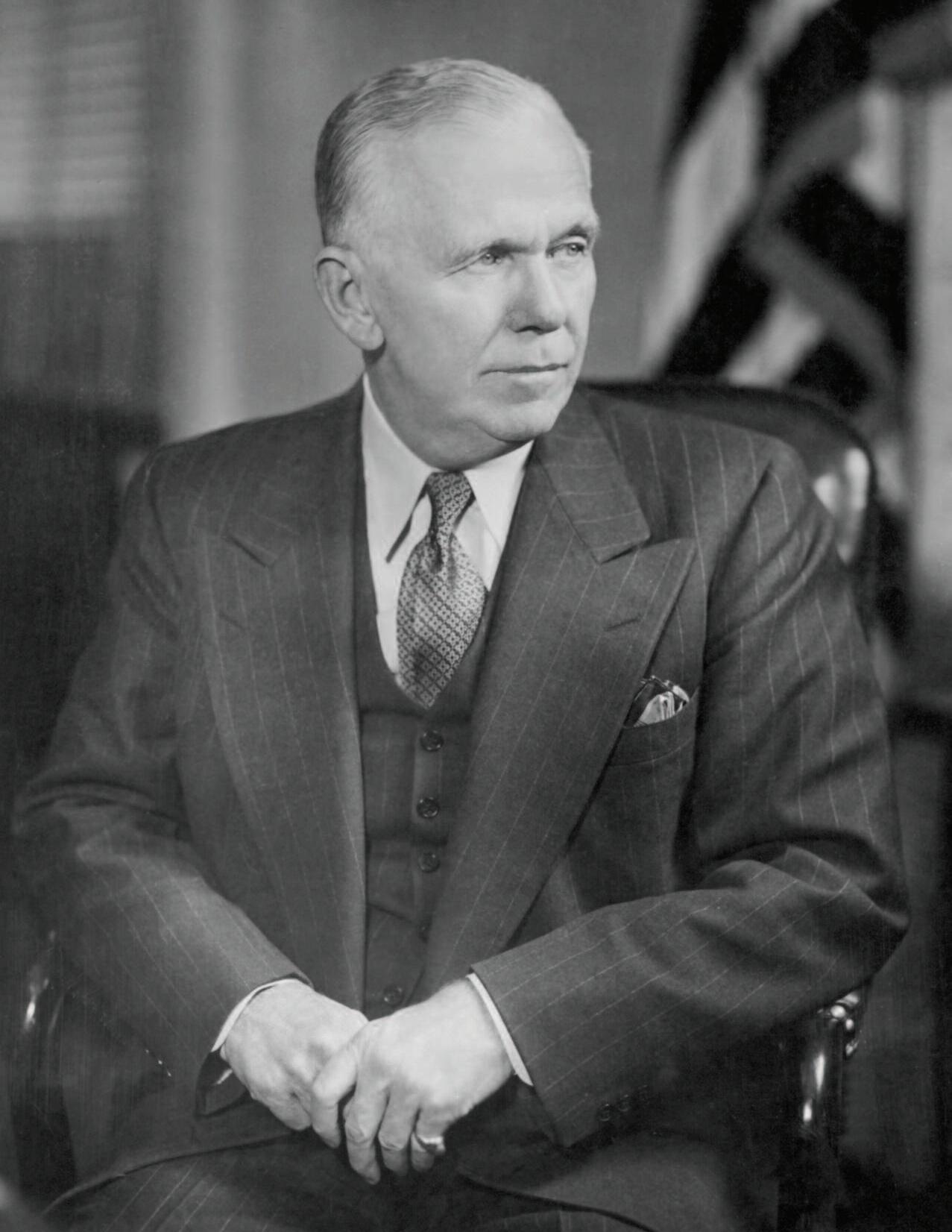
… Marshall’s respect for history and his varied experiences at home and abroad proved instrumental in his response to the European economic, political, and psychological crises of 1947-1948.
M A R S H A L L F O U N D A T I O N O R G
p h o t o c r e d i t G e o r g e C M a r s h a l l R e s e a r c h L i b r a r y
New Light on the Origins of the Marshall Plan
BY B A R RY MAC H A D O, P H.D.
George C. Marshall, the brilliant organizer of his countr y ’ s victor y on World War Two’s battlefields, was with equal brilliance the architect of a revolution in America’s foreign p olic y in the late 1940s. Archival d i g g i ng w it h a d i ffe re nt obj e c t ive has u nc ove re d ke y f a c e t s of t he historical Marshall either missing or indistinct in earlier accounts of his statesmanship.
A fresh understanding of the statesman Marshall what made him tick from 1947 until 1949 is t hat t he p ost war re-order ing of t he At l ant ic world, of w hich t he Europ e an R e cover y Program (ERP) constituted a vital part, rested much more than previously appreciated on four personal traits that Marshall possessed as S ecretar y of State: realism, a historical sensibility, a tolerance of diversity, and empathy.
Marshall’s realism, which prized reconciling means and ends, comprehending limits in national power, and exercising an informed world responsibility, derived from two main sources One was instructive writings by and about Benjamin Franklin. When it came to America’s patriarchs, Marshall preferred Franklin above all others. In fact, along with Robert E. Lee, Franklin ser ved as his historical role model
at other indispensable wellspring was his Christian beliefs, in particular a lifetime adherence to the teachings of his Low Church Episcopalianism His realism, in other words, was a hy brid: Franklinesque and Christian. Hence, Marshall’s advo cac y of t he Europ e an Recover y Program sprang as much from his conscience as from his own imposing intellect
 Benjamin Frank lin
Benjamin Frank lin
Marshall’s advocacy of the European Recovery Program sprang as much from his conscience as from his own imposing intellect
Let’s examine Franklin’s impact first. Marshall’s biographers have offered virtually no help on this matter, yet Benjamin Franklin was a constant presence, an inspirational teacher, throughout Marshall’s life Not a trace of Franklin’s imager y adorns the stately Leesburg residence that the Marshalls called home aer World War II. Nonetheless, Marshall’s o-repeated admiration for a fellow Pennsylvanian inclined him towards a Marshall Plan notably free of ideological rigidity as well as full of common sense and enlightened self-interest
is ar ticle is a summar y of t he aut hor’s Marshall L egac y S er ies t alk for t he Europe’s Unlikely Recover y sequence delivered in Februar y 2018. It is based on his forthcoming book about Marshall, e Education of an American Statesman You can watch Dr Machado’s lecture on our YouTube channel

23 S P R I N G 2 0 1 8
p a n t i n g b y J o s e p h D u p e s s i s
From cradle to grave, Christian teachings molded Marshall’s conscience His conviction that original sin limited human wisdom and virtue anchored itself securely in e Book of Common Prayer. As a regular communicant, he affirmed this central article of faith ever y Sunday morning upon reciting the “General C onfession.”
Faith-based as well as philosophically rooted, Marshall’s realism accounted for his tactical dexterity on ERP’s behalf…
Faith-based as well as philosophically rooted, Marshall’s realism accounted for his tactical dexterity on ERP’s behalf: a readiness to compromise in order to obtain public and congressional support for passage of enabling legislation. Such flexibility also facilitated his adoption of priorities and distinctions among his larger foreign polic y goals. Arguably, without his realism Western Europe might have waited longer to be rebuilt
e tacit bargain Marshall str uck with S enator Ar thur Vandenb erg, chairman of the S enate Foreign Relations C ommittee, about how to sell the Marshall Plan rates as probably the most compelling example of his pragmatism eir two-headed campaign, with S ecretar y Marshall’s resorting to rational persuasion and high-mindedness in a basically educational offensive and the Michigan Republican’s resorting to a shriller, more emotional anti-communism that enlarged the S oviet menace, over whelmed the opposition
e specter always hovering over Marshall’s revolution in Euro-American relations was China. With that countr y ’ s civil war threatening the Marshall Plan’s viability, the S ecretar y of State clung to reason and religion Going with a strong, favorable historical current in Western Europe made vastly more sense to him than testing a dangerous whirlpool in China.
His reasoning amounted to a real-life expression of Reinhold Niebuhr’s “S erenity Prayer”: a w i l ling ness to “accept t he t hings” he cou ld not change in C hina, to muster t he courage to “change the things” he could in Europe, and to seek the “wisdom to know the difference.” Finding a better description of Christian realism in practice taxes the imagination. S enator Joseph McCarthy and his followers never embraced its wisdom, however
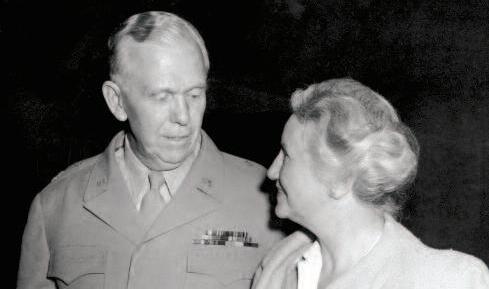
roughout his life Marshall cultivated his historical sensibi lit y. B eg inning in adoles cence, he b e c ame a g re at lover of histor y, far more ardent than previously realized An incessant reader, he tutored himself ab out the past and its less ons. His s e cond w ife, Kat her ine, was abs olutely cor re c t ab out his re ading habits: “he went through a pile of books with the avidity of a swarm of loc usts de vour ing a g re en field.” What he “de voure d” mostly were histories and biographies, not the pulp fiction for which he has received a bad rap
And yet in the fourth and final volume of Forrest Pogue’s excellent biography which covers the secretar y of state years no indication whatsoever exists that his subject ever read a serious book, let alone one that directly influenced his transformative decision-making while running his countr y ’ s foreign affairs out of an office in Fogg y B ottom.
24
M A R S H A L L F O U N D A T I O N O R G
p h o t o c r e d t G e o r g e C M a r s h a l R e s e a r c h L i b a r y
George and K atherine Marshall
As he aged, Marshall compiled an ever-growing librar y of histor y books that went either unnoticed or else uncommented upon until he occupied Quarters No 1 at Fort Myer ey made up the syllabus for what he referred to as his “night reading course. ” His self-schooling in the evening has never received the prominence accorded even his horseback riding in the morning.
But Marshall also had a well-stocked “plane librar y ” For the Army’s Chief of Staff, flying and reading histor y had gone hand-in-hand during World War II, when he spent at least 51 days in the air from Pearl Harbor to V-J Day. Marathon flights abroad, usually on a C-54, gave him plenty of time for airborne historical research
Marshall, it turns out, proselytized on histor y ’ s behalf. Starting with a remarkable speech to the American Historical Association in December 1939, for the next fourteen years he promoted something akin to universal historical literac y for his fellow Americans at crusade has been a heretofore unappreciated companion to his better known and equally unsuccessful campaign for Universal Militar y Training. He meant both to complement the ERP and NATO, intending each as a component of a coherent foreign polic y in a democrac y
Envisioning a republic brimming with amateur historians, just like himself, instead of historical illiterates, like most Americans then and now, Marshall regularly and boldly rebuked professional historians for the off-putting way they wrote and taught histor y He demanded a relevant, usable past right up until his final pitch during his Nobel Peace Prize acceptance speech in Oslo in 1953.
Consequently, by the time Marshall took charge of the State Department, he possessed an acute historical sensibility and a high regard for histor y ’ s lessons, along with the dependable guidance they provided for sound public policies. Especially was he open to further historical instruction upon taking his oath of office, and there are telling examples of how his historical knowledge shaped his decisionmaking while secretar y of state.
Two of those fresh perspectives on how Marshall’s aptitude for thinking historically contributed to the creation of the Marsha l l Pl an must suffice. B ot h const itute pre v iously missing pieces in that intricate puzzle of why the unprecedented foreign aid program came into being Both involved t hat cr it ic a l foresig ht w hich a fir m g rasp of histor y b estowed on the man who reordered the Atlantic world.
During the pivotal and maddening Moscow Foreign Ministers
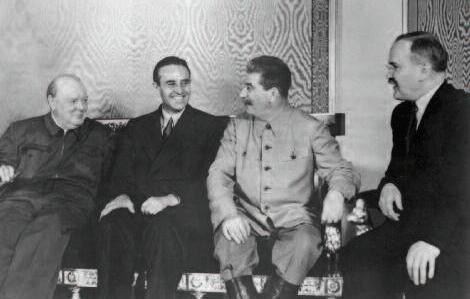
Conference in the spring of 1947, Marshall as much student/teacher as ser vant/leader read avidly the British diplomat and historian Harold Nicolson’s recently published e Congress of Vienna. is book was a gi of British Foreign Secretar y Ernest Bevin Its author focused on an early 19th centur y success in peacemaking. Nicolson’s analysis functioned as either catalyst or rationale for Marshall’s subsequently ending that dangerous dri in Western diplomacy that had ser ved Josef Stalin’s purposes.
In important respects, the book doubled as a manual for securing a modern-day peace by creating an Atlantic partnership, forgiving losers, and checking the ambitions of another Romanov
At the Moscow Conference (from left to right) Winston Churchill, Averell Harriman, Josef Stalin, and Vyacheslav Molotov
25 S P R I N G 2 0 1 8
p h o t o c r e d t G e o r g e C M a r s h a l R e s e a r c h L i b r a r y
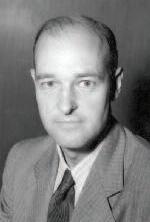
in Mos cow Its mess age was implicit: inste ad of p ost-Nap ole onic France, p ost-Hit ler i an Germany and its economy should be integrated into a new regional system that blocked Russian expansion westward.
What Marshall read about the botched peacemaking that followed America’s Civil War the s o-c a l le d “Era of R e const r uc t ion” conv ince d him as wel l t hat he cou ldn’t le ave Wester n Europeans to “their own devices and resources, ” as C ongressional Republicans did to defeated S out her ners in t he l ate 1860s. B as e d l argely on Amer ic an histor i an and diplomat C l aude B owers ’ s e Tragic Era, a mainstream histor y in its day, Marshall regarded Reconstruction as flawed for two principal reasons: the “absence of any constructive economic support” for the vanquished and a “spirit of vengeance ” on the part of the victor.
Not only did S ecretar y Marshall not wish to repeat America’s irresponsibility aer the Great War for him, living histor y but he believed that two additional lessons of histor y reinforced that attitude. His knowledge of peacemaking aer the Napoleonic Wars and American Civil War provided signposts for doing it right the next time, warnings about the perils of ignoring past mistakes.
As S ecretar y of State, Marshall tolerated diversity on a grand scale, tolerance which he programmed into the Marshall Plan Marshall Planners partnered with governments of the Right, Center and Le, along with royalists, socialists, labourites, Keynesians, supply-siders, Christian Democrats, and secular Muslims. And they managed sixteen counter par t funds by vir tually sixteen different criteria
e earliest stirrings of this trait can be traced to an extended family fractured by the Civil War as well as to his four years at the Virginia Militar y Institute, where he graduated as the lone Northerner in his class at a self-consciously Southern school with blood ties to the Confederacy Physically, his parents had lived in the borderlands. Psychologically, he always straddled regional cultures. e axis of Augusta, Kentucky ; Uniontown, Pennsylvania; and Lexington, Virginia foretold his future
From his Kentucky-born parents Marshall acquired a feeling of cultural in-betweenness. is self-image solidified during his undergraduate years at VMI. ere, an uprooted, transplanted Yankee with an unwelcomed accent experienced non-stop hazing in ser vice to a ver y different point of view. e experience freed him from those biases that came with his accident of birth north of the Mason-Dixon Line.
His choice of historical role models, that odd couple of B enjamin Franklin and Robert E Lee, perhaps best captured the divided, but balanced, nature that resulted. ough both were prominent rebels, Franklin and Lee personified two competing cultural and sectional traditions that achieved peaceful co-existence in Marshall
Marshall’s signature resp ec t for differences als o manifested its elf in his s elec tion of real-life mentors in the U. S. Army : John J. Pershing, John MacAuley Palmer, and Fox C onner. at personal quality further exhibited itself in the selection of his two top departmental advisers, George Kennan and Robert Lovett. ey qualified as another truly odd couple.
26 M A R S H A L L F O U N D A T I O N O R G
p h o t o c e d i t G e o r g e C M a r s h a l R e s e a c h L b r a r y
George Kennan
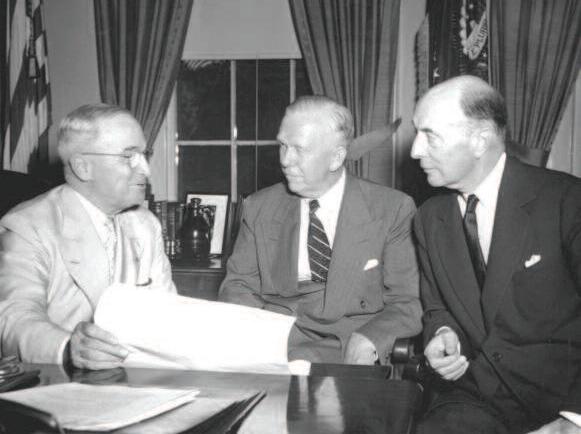
Marsha l l’s tolerance of diversity proved absolutely essential for ERP’s ultimate success. Diplomat, g rand st rateg ist, and int rover t, Kennan delivere d inva luable ana lysis and intel le ctual stimulation Personable Wa l l St re et b an ker and to the manor born, Lovett had t he inter p ers ona l sk i l ls
Kennan sorely lacked. Except for his grand ideas, the Doer had little use for the inker. However, their boss had a different role on his team for men so strikingly different.
As he did for S enator Vandenb erg, his most valuable congressional ally in the dif f icult f ight for ERP’s p ass age. Vandenb erg was Marsha l l’s ant it hesis. Ne w York Times columnist James Reston once des crib ed him as a “ p omp ous windbag,” a vain, “ s elf-imp or tant man who could str ut sitting down ”
For the fate of ERP, he was, indispensable on Capitol Hill. However improbable their association, Marshall, Kennan, Lovett, and Vandenberg played team ball at its finest, principally because the “Old Man” understood how to balance diversity and community is unusual talent he demonstrated again in establishing guidelines for implementing the plan that bears his name and confers on him immortality.
Little understood in previously published accounts, Marshall’s extensive travels, at home and abroad, deepened and broadened an empathy that assimilation at VMI and thinking histor ically instilled indep endent ly In combination, voracious reading and decades of wandering ser ved a perpetual student as outstanding tutors.
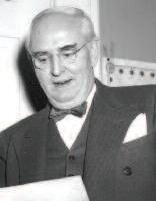
During his long military career Marshall came to know, first hand, nearly every region of his own country and a good deal of the rest of the world.
During his long militar y career Marshall came to know, first hand, nearly ever y region of his own countr y and a good deal of the rest of the world In fact, from 1901 until 1947, he spent fully one-fih of his adult life overseas. In particular, two years living in France during World War I, three-and-a-half years in China, and, most unexpectedly, three years in Chicago in the mid-1930s imparted intimate knowledge that book learning could not Indeed, Marshall’s life reminds us of the limits of book learning.
Marshall’s social interactions in France from 1917 until 1919 conveyed emotional dividends China supplied intellectual dividends And Chicago provided political dividends All functioned as outsized classrooms, where insights of future benefit in how best to promote ERP’s passage accumulated. E ach lengthy posting also made its valuable contribution to the specific shape the landmark aid program ultimately assumed
27 S P R I N G 2 0 1 8
p h o t o c r e d t G e o r g e C M a r s h a l R e s e a r c h L i b r a r y p h o t o c r e d i t G e o r g e C M a r s h a R e s e a r c h L b r a r y
President Truman, Secretar y Marshall and Undersecretar y Rober t Lovett
Senator Ar thur Vandenberg
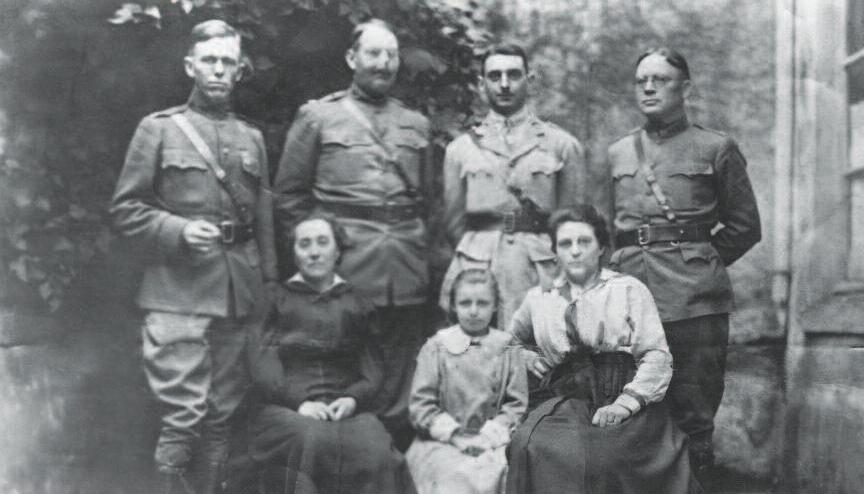
In France, the Army billeted Marshall in farmhouses in the countr yside where he came to know intimately French artisans, farmers, workers, and peasants and to comprehend their wartime suffering. He also developed a lasting bond with his landlady. eir friendship endured until her death in the early 1950s. When fully reconstructed, it is a moving testament to Marshall’s compassion and humanity
e same magnanimity of spirit which characterized his personal relationship with Madame Veuve Jouatte, who extended him numerous kindnesses during his six months under her roof, Marshall transferred, in effect, to her countr ymen aer World War II She and her neighbors gave France a human face, imparting life to a mass of bloodless economic statistics a generation later.
Marshall’s social interactions with the French people during the First World War humanized the plight of all Western Europeans aer the Second World War ey allowed him, thirty years later, to perceive continental distress through a familiar Gallic lens. ey assured that his heart, as well as his head, was always in the Marshall Plan’s mission.
… he structured the essence of the Marshall Plan… “Only Europeans themselves can solve their problem.”
Marshall’s exp eriences in China f rom 1924 until 1927 and later during the entirety of 1946 operated as a const ant reference p oint in his for mu l at ion of Amer ic a ’ s postwar foreign polic y, lending themselves profoundly as reinforcement for his realism and humility. e sum of insights obtained from living in China provided crucial tutelage for constructing foundations on which Marshall built the ERP China in upheaval was a primer for Realism 101
Marshall’s most important takeaways amounted to a brace of unshakeable convictions. e first dealt with limits on American power, specifically about Washington’s inability to control the Chinese political situation, which rendered economic assistance futile and any Nationalist militar y successes against the Communists on the battlefield illusor y e second pertained to the Chinese government and people as the only ones capable of solving their countr y ’ s fundamental problems.
Marshall’s latter conviction morphed into a “First Precept of Statesmanship ” Around this foundational precept he structured the essence of the Marshall Plan. It should be familiar to all its students: “Only Europeans themselves can solve their problem.”
Never getting as much media play as America’s open-ended commitment in the Truman Doctrine, Marshall’s dictum made clear that the United States was no redeemer nation. It could
28 M A R S H A L L F O U N D A T I O N O R G
p h o t o c r e d t G e o r g e C M a s h a l R e s e a r c h L b r a r y
Marshall (standing, left) and Madame Jouatte (seated, left) and others who shared her house in 1917
save neither China nor Europe from itself An insight once gained in China he transferred to Western Europe Years in the Middle Kingdom le him, in other words, clear eyed about preconditions for a workable Atlantic partnership. He concluded that a synerg y between American aid and Western European self-reliance promised a success that tr ying to right the wrongs in China could not
Finally, that little-known, much under valued time he spent in the Windy City from 1933 to 1936 also merits attention. Purely by happenstance, Marshall came to know well both Charles Dawes and Robert McC ormick during his three-year residence there Had he not accepted an unwanted reassignment as senior instructor to the Illinois National Guard, headquartered in the Loop, the Marshall Plan might never have come to pass in the manner it did.
A private American financier and Calvin Coolidge’s vice president, Dawes had organized in 1924 the Dawes Plan which sought to solve Germany’s reparations problem. In some ways it stands as a forerunner of the Marshall Plan. Editor and publisher of the Chicago Tribune, McC ormick became a future vociferous adversar y of Marshall’s Aer the Second World War, the two were fated to be symbols of foreign policies in opposition. e Colonel led the resistance to the ERP throughout Middle America, also known as Tribune-land. He pitted his isolationist creed and conspiratorial ideas against Marshall’s support for unprecedented involvement in European affairs
Fortunately, Marshall’s encounter with Chicago acquainted him with the businessman whose private plan for reconstructing a ravaged Europe aer the last war had failed, as well as with his staunchest opponent in tr ying to win over public opinion to the necessity of a colossal government aid program aer the next war. A fan of Sun Tzu, Marshall knew his principal domestic enemy before entering into a battle with Atlantic solidarity at stake. Foreknowledge had le him forearmed
Living in Lexington, France, China and Chicago yielded invaluable tutelage for a future statesman. Like his love affair with histor y, each place stretched his mind, enhancing his understanding of ot her p e ople’s ver y different p oints of v ie w B esides foster ing inter na l and exter na l perspectives on America itself, each diminished narrow-mindedness in ways that had direct applications to how he conceptualized a workable European Recover y Program. In combination, George Marshall’s respect for histor y and his varied experiences at home and abroad proved instrumental in his response to the European economic, political, and psychological crises of 1947-1948. ey meant that in calculations of national interest an American statesman brought heart, conscience, and intellect to bear In concert, they all le him ready when, attired in a three-piece suit rather than a uniform, histor y ’ s bell again tolled
Barr y Machado taught courses in U.S. militar y, political, diplomatic and business histor y at Washington and Lee Universit y for 34 years until his retirement in 2005 A graduate of Dar tmouth College and Nor thwestern University, he is author of several books about post-World War
II, including I n S e a rc h o f a U s a b l e Pa s t : Th e
M a r s h a l l Pl a n a n d Po s t wa r R e co n s t r u c t i o n
Today, and a contributor to several books about the M arshall Plan and the Cold War H is new book , The Education of an American Statesman, is in the process of being published.

29 S P R I N G 2 0 1 8
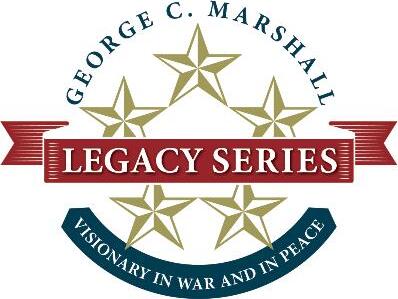
Exhibition Features Marshall Plan Posters
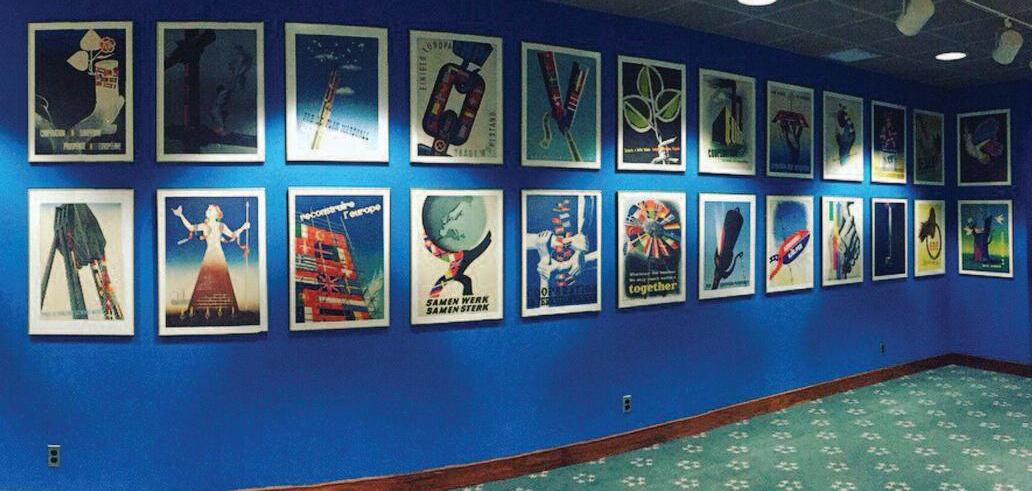
B eginning in the fall of 1950 artists from the Europ ean nations par ticipating in the Marshall Plan submitted more than 10,000 entries for a p oster contest embracing the theme “Intra-Europ ean C o op eration for a B etter Standard of Living.”
Following r un-off comp etitions lo cally, a selection of the best posters from each countr y was submitted to Paris to be judged by a distinguished intra-European jur y composed of repres entatives of the graphics and fine ar ts fields, museum directors and curators, educators and information specialists from twelve of the thirteen participating countries
What is interesting to note about these posters is the year in which the y were commissioned 1950 three years aer G eorge C.

Marshall gave his speech at Harvard University and two years aer the Europ ean Recover y Program had b ecome op erational. ERP aid had been supplied to all the countries of western Europe So why a poster contest now?
ese posters were intended to promote the idea of Western Europe cohesion and an integration of all the countries with the removal of trade barriers and inter-governmental institutions to aid in trade. Many of designs use multiple countr y flags to depict this ne w union It is not surprising then that the winning design depicts a one-Europ e ship with sails made f rom flags f rom each countr y Twenty-five winning p osters were s elected, and a first prize of $1,500 was awarded to Dutch ar tist, Re yn Dirks en, for his p oster titled, “All Our C olours to the Mast,” which
30 M A R S H A L L F O U N D A T I O N O R G
Original lithographs hang in the lower galler y exhibition, “Hope for Those Who Need I t.”

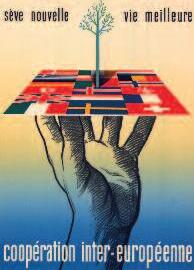
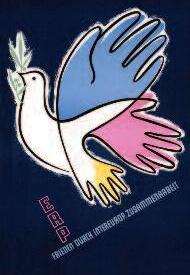



has been used for the front cover of this issue of the magazine All 25 original posters are on display in the Museum through June.
is year marks the 70th anniversar y of the signing of the Marshall Plan into law e Marshall Foundation has invited teachers and their students to participate in a 2018 Marshall Plan Poster contest inspired by the original contest held in Europ e. Students have b een encouraged to draw inspiration from the 1950 p oster comp etition and submit their entries before May 31. A winner or winners are expected to be announced the following week.
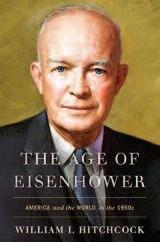

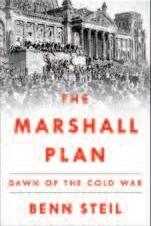
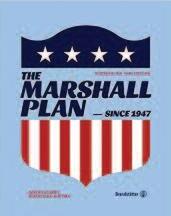


Some of the top 25 finalist posters (left)
The entrance to the Marshall Plan exhibition (below)
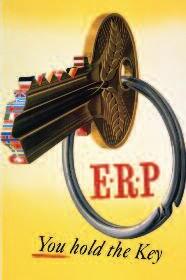
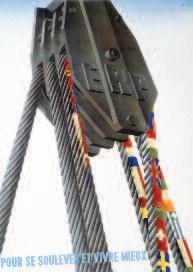
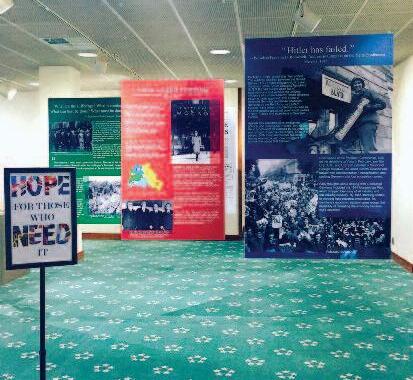
e Marshall Plan: Daw n of the Cold War (2018) by B enn Steil
L
Europe’s Unlikely Recovery
Jan June 2018
May 10
Dr Regina Longo discusses Marshall Plan Films and Italian Cinema
June 5
Marshall Plan Day at the Museum and Library
To see the lineup for the rest of the Marshall Legacy Series, go to our website.
e Age of Eisenhower, America and the World in the 1950s (2018) by William Hitchcock
e Marshall Plan: Sav ing Europe, Rebuilding Austria (2017) by Günter Bischof and Hans Petschar
31 S P R I N G 2 0 1 8
g
c y S e r i e s
e
a
E D U L E
S C H
N E W B O O K S A B O U T O R I N C LU D I N G M A R S H A L L
the last word
“ M a r s h a l l h a d a
p o w e r o f c o m m a n d
t h a t I h a v e n e v e r
s e e n e q u a l e d . H e
w o u l d l i s t e n c a r e -
f u l l y t o a l l s i d e s o f
a q u e s t i o n a n d t h e n
m a k e u p h i s m i n d .
O n c e t h e d e c i s i o n
w a s m a d e , t h e r e w a s
n o t u r n i n g b a c k , a
Secretar y Marshall and Undersecretar y of State Rober t A
Lovett appear before the Senate Foreign Relations Committee in November 1947 to address the need for economic aid to Europe With arms crossed, Charles "Chip" Bohlen is seated in the row behind them along with other State Depar tment staff members
c h a r a c t e r i s t i c t h a t
a p p a r e n t l y w a s
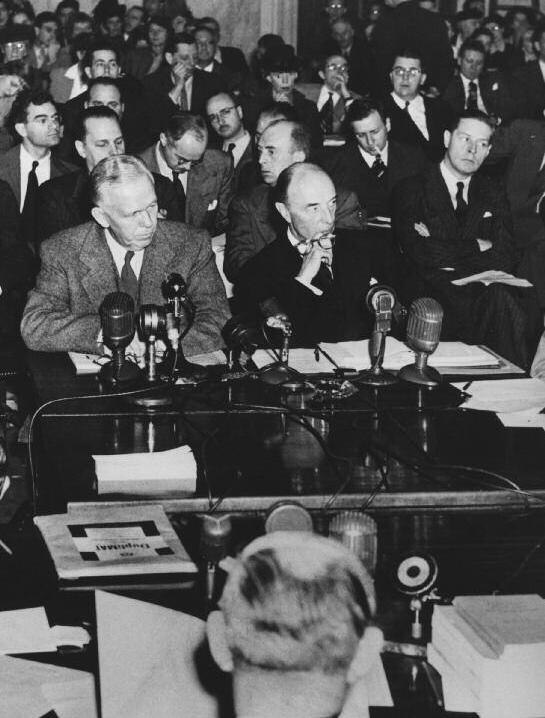
d e v e l o p e d d u r i n g h i s m i l i t a r y t r a i n i n g . H i s p e r s o n a l i t y i n f e c t e d t h e e n t i r e S t a t e D e p a r t m e n t . I t g a v e i t a s e n s e o f
d i r e c t i o n a n d p u r p o s e . H e w a s n o t a g r e g a r i o u s m a n—h e
d i d n o t k n o w m a n y p e o p l e a t S t a t e—b u t i t d i d n o t t a k e l o n g a f t e r h i s a c c e p t a n c e o f t h e p o s t o f S e c r e t a r y f o r h i s c h a r a c t e r
t o p e r m e a t e t h e d e p a r t m e n t . We r e a l i z e d w e w e r e w o r k i n g
f o r a g r e a t m a n . ”
— Charles “Chip” Bohlen in Witness to Histor y, 1929-1969
Bohlen drafted the remarks (the Marshall Plan speech) that Secretar y Marshall delivered at Har vard University on June 5, 1947 Later he would succeed George F Kennan as U S ambassador to the Soviet Union
32 M A R S H A L L F O U N D A T I O N O R G
p h o t o c r e d t G e o r g e C M a s h a l R e s e a r c h L b a r y
By renewing your membership, you help us perpetuate t h e l e g a c y o f t h e m a n Pre s i d e nt H a r r y Tr u m a n called “the great one of the age.” As the keeper of the flame, the Marshall Foundation preser ves and commun i c ate s t h e re m a r k a b l e s to r y o f t h e l i fe a n d t i m e s o f
George C. Marshall and his contemporaries. I t has become a unique, national treasure wor th protec ting at all costs. That ’s why your membership is so impor tant.
KEEP MARSHALL’S LEGACY ALIVE
Levels of Membership Benefits of Membership

Unlimited free Museum admission during the membership year
New members receive a Five-Star lapel pin
Receive the newsletter, The Strategist
Receive two issues of our magazine, MARSHALL
Free admission to most Legacy Series events
Receive 10% discount in the Museum Shop

Reciprocal admission to 950 NARM-member museums
New members receive The Words of George C Marshall
Receive a private tour of the Archives
Receive a bust of Marshall civilian or military
Receive a table at a Foundation award event


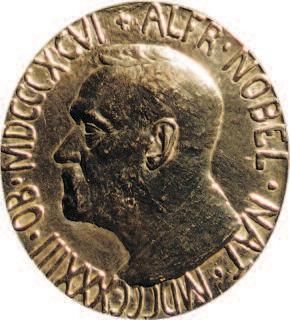
H HHHHHHH HHHHHHHH HHHHHHHH HHHHHHHH HHHHHHHH HHHHHHHH HHHHHHH HHHHHH HHHH HH H $75 $150 $250 $500 $1,000 $2,500 $5,000 $10,000
Friend Associate Colleague Supporter Partner Leader Visionary Strategist
annual contribution of at least: i n d i v i d u a l d u a l
An
It’s
our
Marshall received this Nobel Peace Prize in
1953
on display in
museum
Original busts of George C Marshall by Dan Booton
P O Box 1600, Lexington, VA 24450
P O Box 1600, Lexington, VA 24450
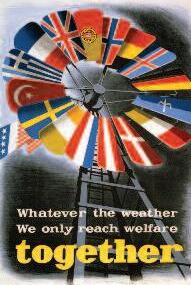
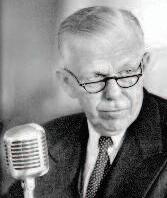

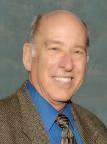

I N S I D E T H I S I S S U E
is magazine, in tandem with our Marshall Legacy Series and other initiatives, brings Marshall to life substantially and in a fashion that does justice to the complexities of his life, character and career.
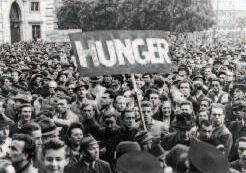
M a r s h a l l , S o l d i e r o f Pe a c e
M a r s h a l l P l a n , D e f e n d i n g D e m o c r a c y
N e w L i g h t o n t h e M a r s h a l l P l a n
M a r s h a l l L e g a c y S e r i e s











 Rob Havers, President
Rob Havers, President































 Benjamin Frank lin
Benjamin Frank lin




































